 |
|
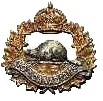 |
George Henry Scott
Private
21523
10th Bn., Canadian Army
who died in action
Thursday 22 April 1915. Age 26
THERE IS NO KNOWN PHOTOGRAPH OF
GEORGE HENRY SCOTT
The Memorials
George has no known grave. His name appears on the Menin Gate Memorial plaques in Ypres. Ypres (now Ieper) is a town in the Province of West Flanders. The Memorial is situated at the eastern side of the town on the road to Menin (Menen) and Courtrai (Kortrijk). Each night at 8 pm the traffic is stopped at the Menin Gate while members of the local Fire Brigade sound the Last Post in the roadway under the Memorial's arches.The Memorial Roll
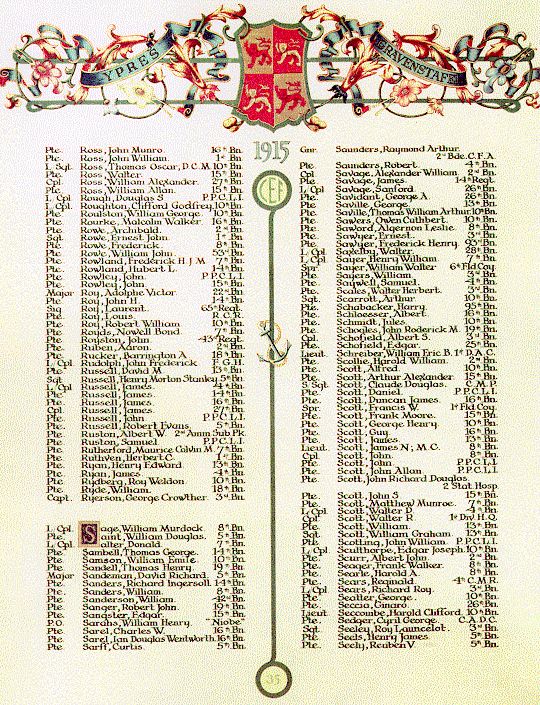 |
|
The Memorial Roll
in the Peace Tower in the House of Commons
in Ottawa
This roll lists
all of the war fatalities of the Canadian
Forces and the page shown above includes the
name of George Henry Scott.
|
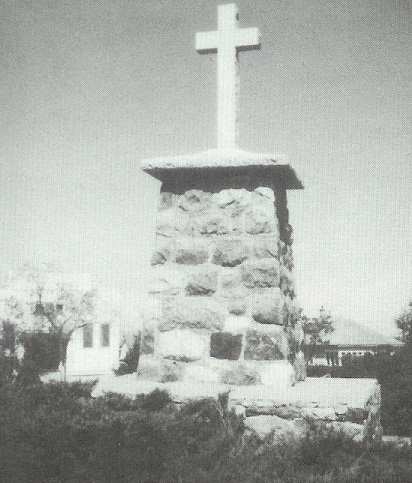 |
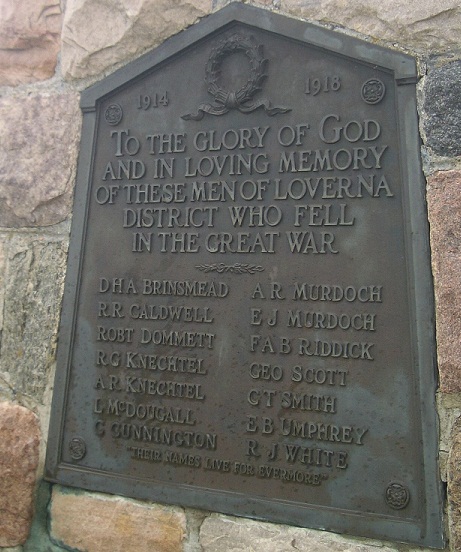 |
| The memorial as
illustrated in the town history |
A close up of the
dedication plaque on the memorial |
There is an on-line registry of commonwealth dead which contains information on George Henry Scott
The Military Service of George Henry Scott -- Part 1,
The Royal Navy
George began his military career as a sailor in the Royal
Navy. His naval military record has been obtained from the
National Archives in the U.K. and is shown in the following
images.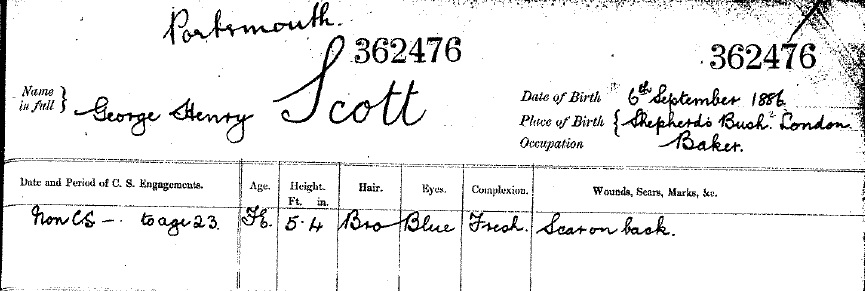 |
| This portion of his
navy record gives his basic biographical and
physical information. He is given the service number
362476. His birth date is listed as 6 September
1886, whereas he was actually born on that day in
1888; he adjusted his age to gain employment while
under age. He is 5 ft 4 inches high with brown hair,
blue eyes and a fresh complexion. He has a scar on
his back |
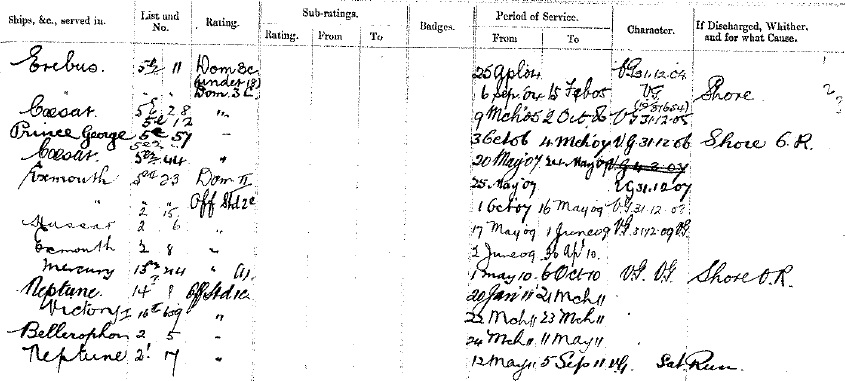 |
| This portion of the
record lists the ships, dates and ratings that
George had during his assignments in the navy. |
We see that he took his first assignment as a domestic servant on 25 April 1904 aboard the Erebus, being promoted to domestic servant third class on 6 September of that year. he received V.G. (Very Good ) character assessments. He serves on a number of different ships until September of 1911.
On 25 May 1907 he is taken on board the H.M.S. Exmouth as a domestic servant 2nd class and in Oct of that year he becomes a officer's steward 2nd class.
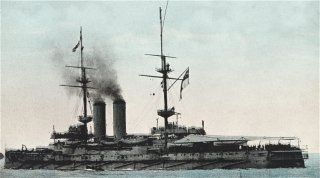 |
In the photograph at left HMS Exmouth is shown as she would have appeared in the Mediterranean with her awnings unfurled to provide shade on the after deck. The Exmouth entered the fleet in 1903. After a refit in 1907 she recommissioned on 25 May 1907, the day that George joined her, to serve as Flagship, Vice Admiral, Atlantic Fleet. On 20 November 1908 she transferred to the Mediterranean Fleet to serve as flagship there, and underwent a refit at Malta in 1908-1909. George was on the Exmouth almost continuously until the end of April in 1910. |
During his assignments on the Exmouth, George spent a considerable amount of time in the Mediterranean and in particular at Malta which is where the Mediterranean fleet was based. George was an artist and it is likely that the following paintings by him were done during this period.
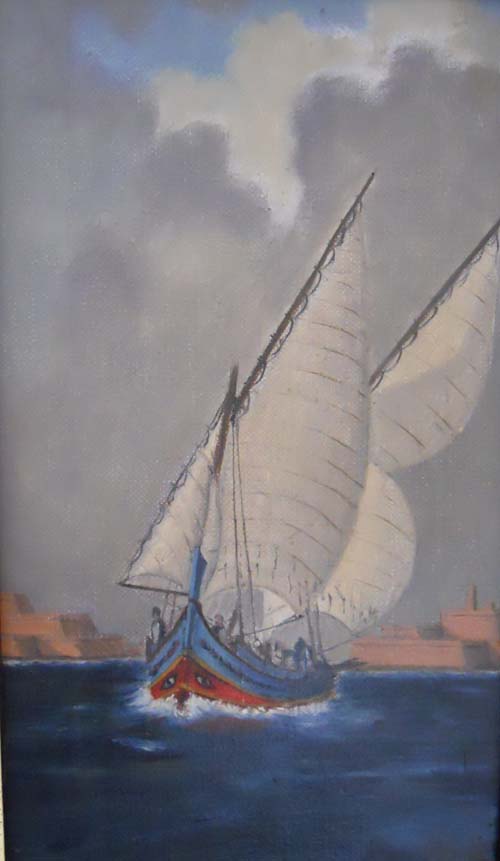 |
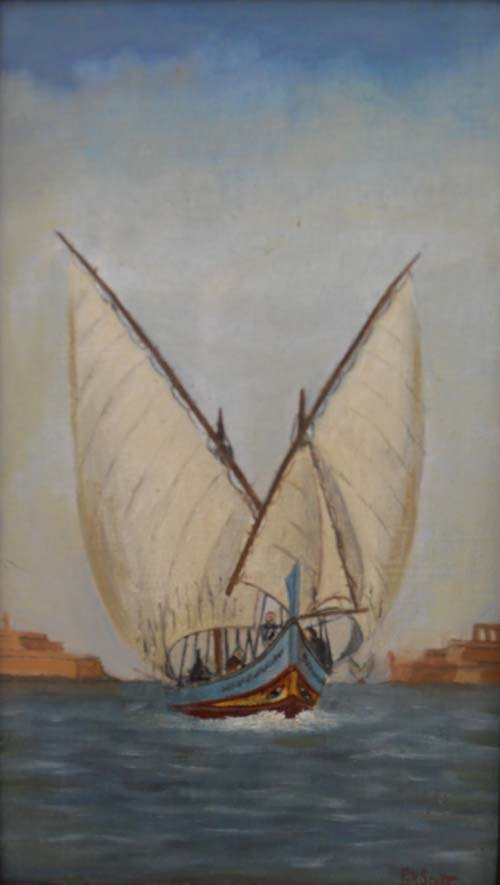 |
||
|
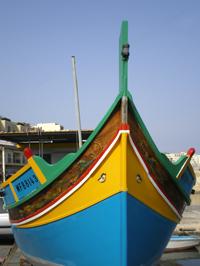 |
||
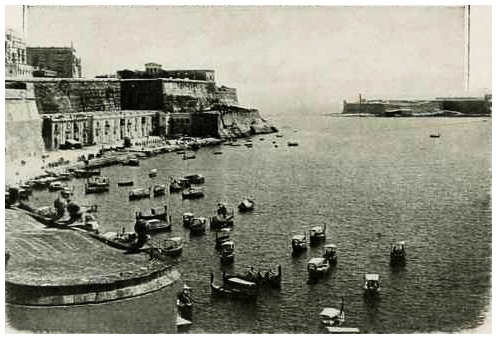 |
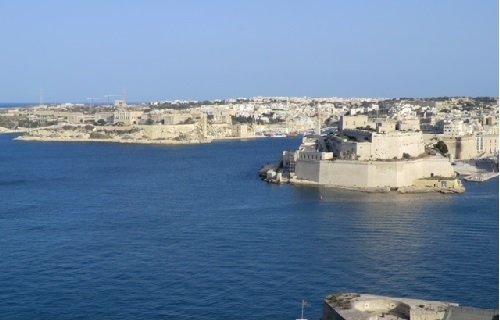 A Recent Photograph of Castel
Sant'Angelo
|
| Leo Costell, who was a boy in Malta in the period 1945 - 55, and who visits there frequently, recognized the scenes painted by George and forwarded the two photos above and the following comments: "[the] paintings of the luzzus certainly can be situated in Malta's Grand Harbour: as one looks out to sea, Fort St Elmo is to the left and Fort Ricasoli to the right. His viewpoint was off Fort Sant'Angelo, probably from a naval vessel moored close to Dockyad Creek, Vittoriosa." | The above is a view of Castel
Sant'Angelo with Fort Ricasoli to the left and
Dockyard Creek to the right.Castel Sant'Angelo is
visible in both of the paintings by George that are
shown above. |
On the 20th of January of 1911 George was promoted to Officer's Steward first class on the Neptune. From the 24th of March to the 11th of May George was on the Bellerophon. It was during this time that the 1911 census was taken and George's name is included on the Bellerophon crew roster.
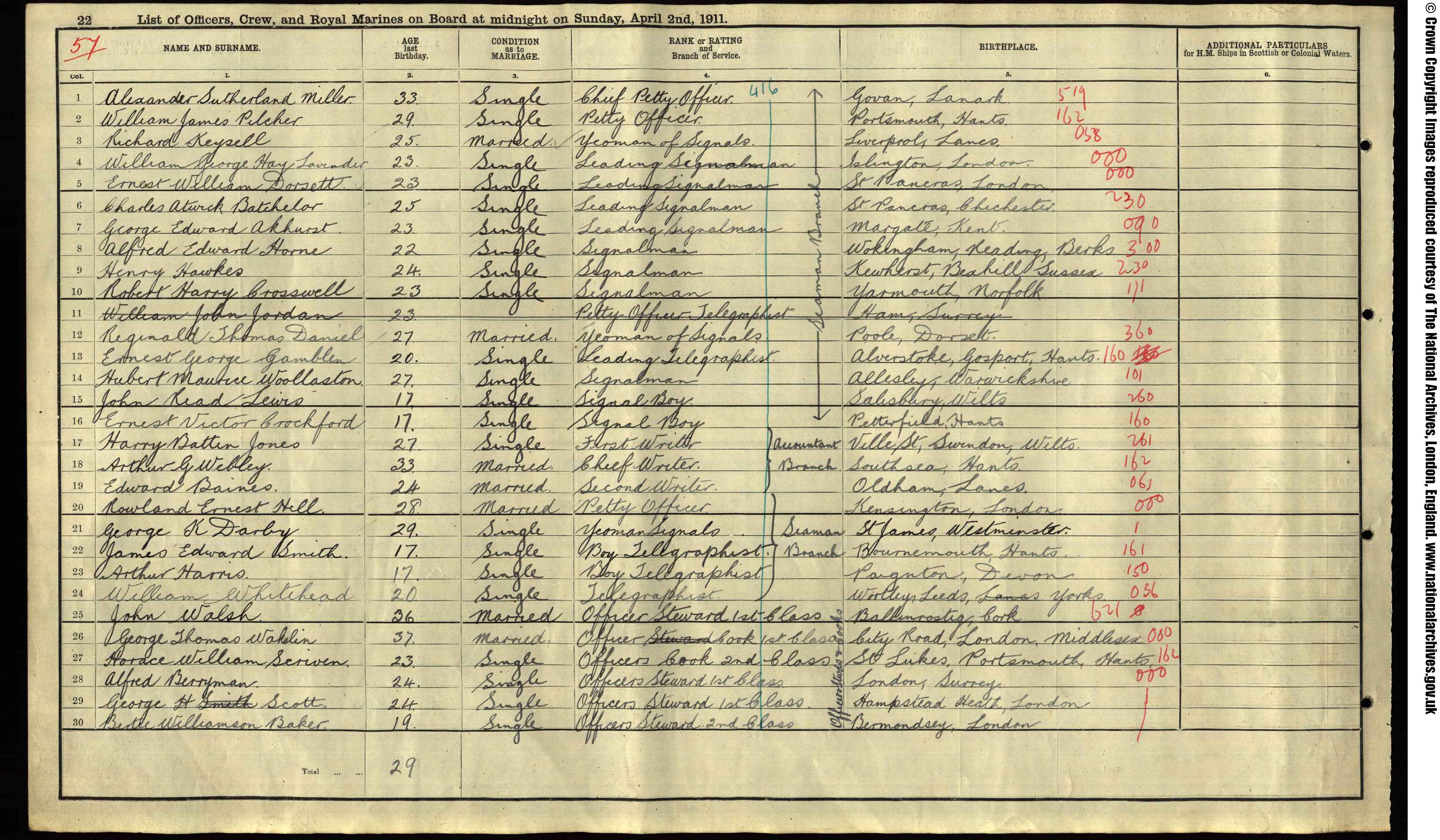 |
| George appears in
the 1911 census on the second last line of this
listing. He is an officer's steward, 1st Class, 24
years of age born in Hampstead Heath, London. [note that his actual age was 22, perpetuating his age adjustment at the time of enlisting]. |
One wonders what happened next. Did he go home? This would have created problems for two of his brothers, one of whom was a policeman and another of whom was a sailor. We do know that by January 1912, four months later, he was in Saskatchewan, Canada (see more details below).
The Military Service of George Henry Scott -- Part 2,
The Canadian Army
[note: many of the comments below
come from the military file on George Henry Scott which is
preserved by Archives Canada and which I have copied in
their entirety]For many Englishmen who had emigrated to Canada, the outbreak of war led them to enlist in the Canadian Forces. At that time Canada was a Dominion but much of its foreign policy was determined in London. When war was declared by Britain, Canada was at war and mobilized by committing to the creation of a Canadian Expeditionary Force that would go to Europe and fight as part of the British Empire Military.
The Canadian Expeditionary Force (CEF) was a separate
entity created by Canada's Minister of Militia in 1914 for
service to Britain in the First World War. Technically
distinct from the standing land forces in existence at the
time, soldiers were legally attested into the CEF in order
to serve overseas. Hughes, the minister of defense,
refused to mobilize the existing Militia units as units,
and instead numbered battalions were created into which a
combination of Permanent Force (regular) soldiers, Militia
(reservists) and civilian volunteers were combined.
George Henry was from the town of Loverna, although he
may have been working in Kindersley at the outbreak of the
war. There was a photograph published on August 20,
1914 of men from Loverna who were "eager to enlist".
George Henry may have been one of these Loverna
volunteers. So far I do not have identities for any of
them. There is also a photograph of the men from
Kindersley who were enlisting on 19 August 1914. Geo might
be one of them. He was paid from the 12th of August, but
might not yet have left the area.
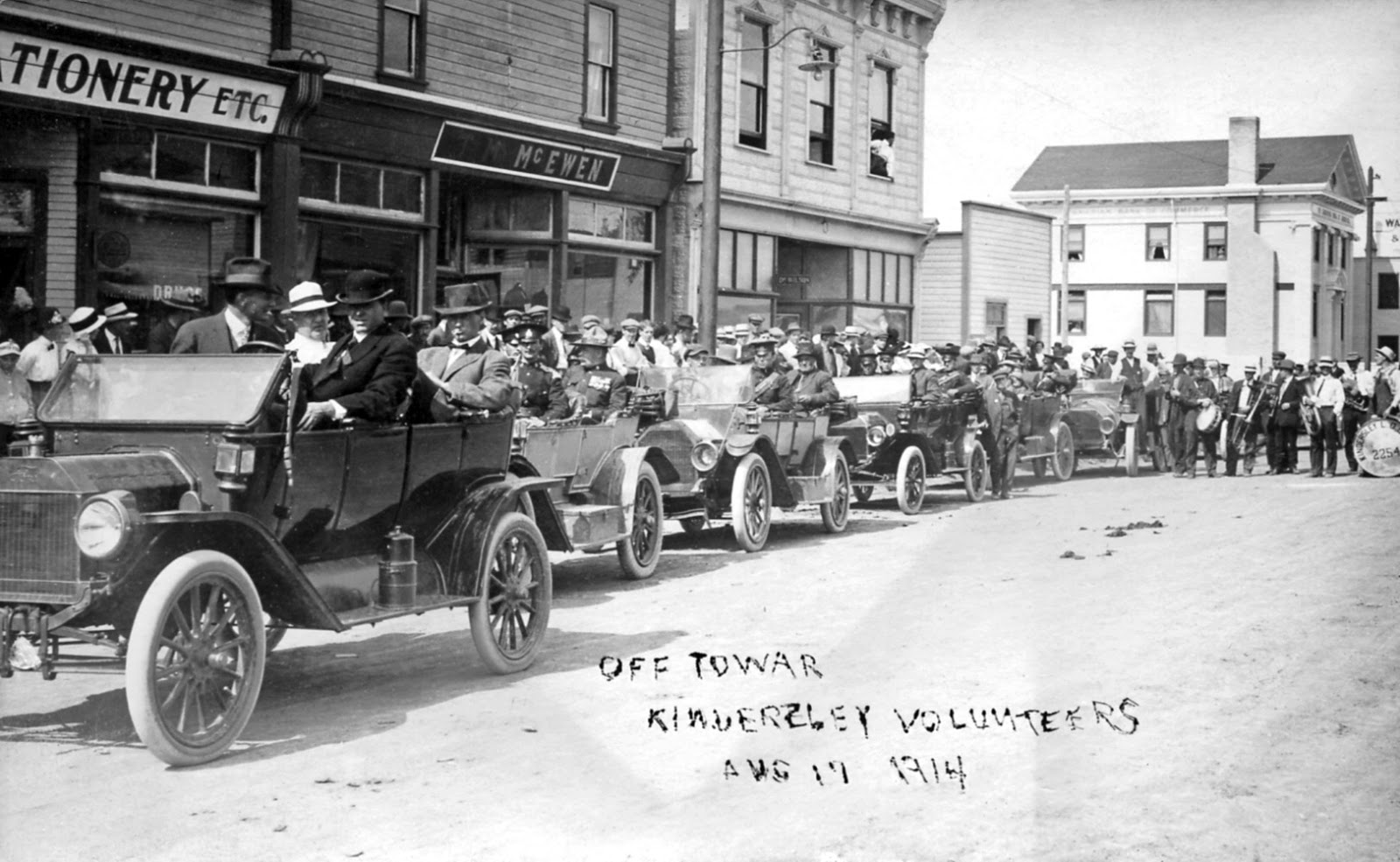 |
George Henry appears to have initially enlisted in the
105th Regiment, the Saskatoon Fusiliers on about 12
August, 1914, as, according to the following pay record
that is in his file, he was being paid from that date.
This document also reflects that he was transferred to
the 11th Battalion pay list in the September time frame
prior to sailing to England on the SS Royal Edward on Oct
3 1914.
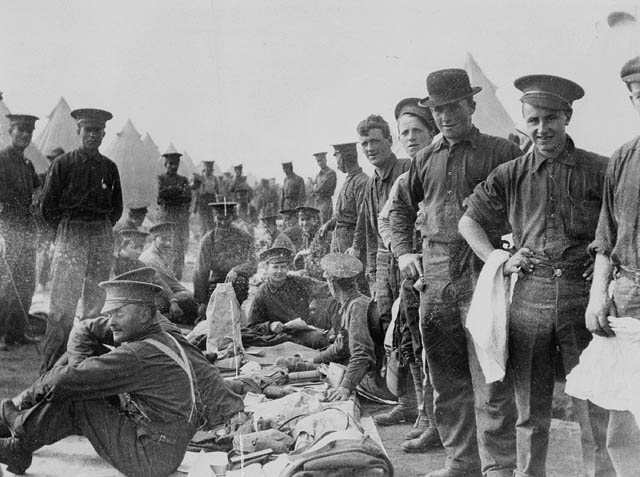 |
| This photograph shows
a kit inspection of the 11th Battalion at
Valcartier. Sadly, the Canadian Army personnel
records of this time do not include photographs of
soldiers. Was our George Henry in this group? |
The following images are the attestation papers of George which clearly indicate his date of birth, his place of birth and that fact that his next of kin is J.T. Scott of 57 Paxton Rd. Fareham, Hants, the address on his father's 1911 census form. Because of this information we can be fully sure that this record relates to the George Henry Scott in our family. The attestation paper provides other information that is of interest in our learning about George and his life. Firstly, it is here that we learn he is a Canadian farmer, although we do not know precisely where he is farming. He is 5' 7 1/2 " tall (having grown 3 1/2 inches from the time he enlisted in the Royal Navy), of fair complexion with light blue eyes and dark brown hair. He has a scar on his lumbar region and four vaccination marks on his arm. He states that he is not married and further states that he has never had any military service (had he declared his previous experience in the Royal Navy he would likely have been asked for his discharge papers leading to possible arrest and imprisonment for desertion). The attestation paper also gives his birth date as September 6, 1888.
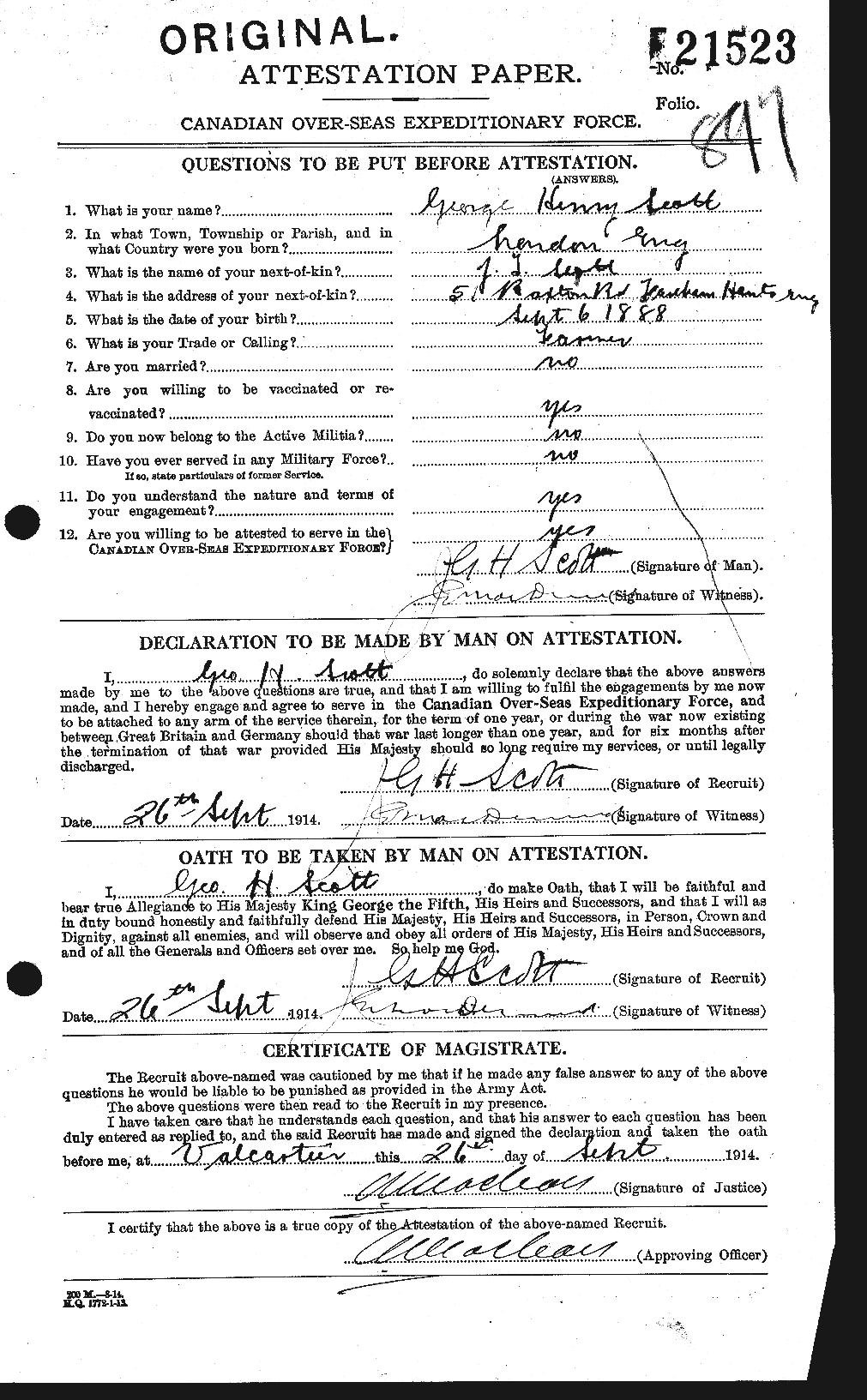
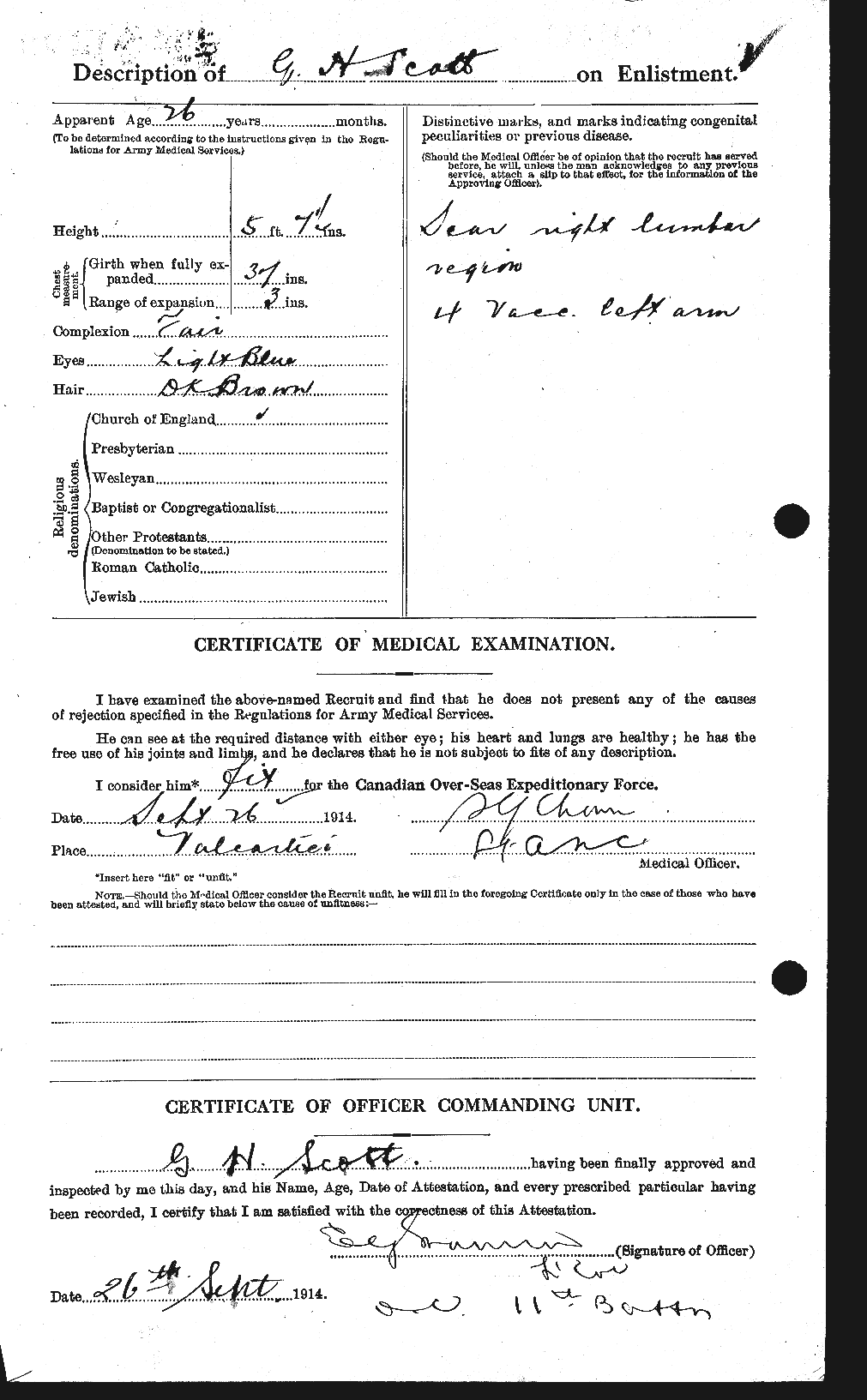
In a period of three weeks a camp was created at Valcartier Quebec, 13 miles (20 kilometers) north west of Quebec City. George arrived at this camp on or before 26 September, the day that he was transferred to the 11th Battalion as recorded in his attestation papers. A week later on 3 October, after a total of about 5 weeks in the army he was on board the SS Royal Edward sailing back to England with the 1st contingent of the Canadian Expeditionary Force.
The CEF arrived in England on 14 October and was moved to military barracks on Salisbury plain, about 40 miles north west of his parents home in Fareham, Hampshire. In these early stages of the CEF over 75% of the members had been born in Britain. During their stay at Salisbury, in addition to the training they received, they would have had ample opportunity to visit with family, both in the vicinity of their base and at their family homes. We can assume that George, with four brothers and three sisters as well as his parents near by, had the opportunity to re-establish his family connections. There were probably also some photographs taken during this time of him in uniform with or without family members. Sadly no photographs seem to have survived.
While in England the CEF received training and equipping for its coming role on the Western Front. At these early stages of the war the essentially static trench warfare that was to characterize the war was just coming into being. Techniques that were evolving at the front would only partially make their way back to the training curriculum in England and so much of the time was associated with marching, use of the rifle and other basic military skills.
All to soon the CEF was to proceed to the continent. As part of the process a number of battalions that were going were brought up to full strength by transfers from other battalions that were not going at that time. In this process George was transferred from the 11th battalion (Saskatchewan rifles) to the 10th battalion (Alberta rifles) on 2 February 1915. He had little time to fit into this new battalion.
So far we have no knowledge of the personal details of the rest of George's life and death. However the actions of the 10th Bn. are recorded in the battalion's war diary and give us a general idea of his location and the kinds of activities he was involved in.
At the time of his transfer to the 10th that battalion was involved in training. Mostly, on a day by day basis prior to leaving for France, this consisted of marching and musketry. However, on 4 February at 9:00 am the battalion. marched to a review area where at 11:00 am it was reviewed by H.M. the King, Lord Kitchener and staff. This was probably a Canadian Brigade or Division review, scheduled for just before embarkation to France.
On the 6th at 9:00 am there was a battalion parade at which sections 4 to 44 of the Army Act were read to the men and which G.H.Q. (General Headquarters Orders) were read to all ranks. These readings, prior to going into the war zone would remind the mean of issues such as treason, cowardice, disobedience, criminal acts etc. and the punishments which could occur under military law.
During this period, too, from the 4th until the 9th the battalion was busy issuing equipment and ammunition as well as making other preparations for the move. On the 10th of February, they were up early at 4 am and moved off in two groups to Amesbury to be entrained en route to Avonmouth near Bristol on the Severn, arriving there in the afternoon. In the late afternoon the whole battalion was loaded on the S.S. Kingstonian which sailed at 5:00 am.
They had a rough crossing in heavy seas and winds and did not drop anchor until the 13th at St. Nazaire. However the ship lost anchors and drifted onto a sand bar and the disembarkation, except for two platoons, did not occur until the 15th. During this whole crossing conditions were cramped and very uncomfortable with much sea sickness in the holds. Finally on at noon on the 15th they left by train for the front, stopping at Le Mans at midnight and arriving at Borre in N.E. France at 7:00 am on the 16th. Likely the men were traveling in the 40-8 rail cars (40 men or 8 horses) while the officers would have been in passenger cars.
By mid-morning on the 16th they were in billets at Borre where they passed a couple of days recovering and reorganizing from the trip. For most of the men this would have been the first exposure to France and although being in billets promised some interaction with the local populace, it would not have been much. Often the men were billeted in barns and they were under close military supervision most of the time with continual duties by way of work details and personal equipment maintenance.
While not the first Canadian troops to enter the battle in France (the Princess Patricia's Canadian Light Infantry had arrived on Dec 21 1914), the Canadian First Division of which the 10th was a part, was the first large Canadian contribution to reach the front. Accordingly, at 10 am on the 20th the battalion was marched about 2 miles to Strazeele where it was inspected by Field Marshall Sir John French who commanded all British troops in France. This was followed by reading orders regarding discipline to the men.
On the 21st the battalion marched about 10 miles to Romarin, Belgium and into the trenches. From this time until 2 March elements from the battalion were mixed with experienced troops of the Royal Irish Fusiliers, the Dublin Fusiliers, the Seaforth Highlanders and the Warwicks where they learned trench digging and maintenance as well as how to act in the trench environment. On the 22nd the first elements of the battalion to experience enemy shelling did so without receiving casualties. However, by 25th the first casualties are listed in the war diary: 21460 Pte. W. Davis was killed and buried with the Seaforth Highlanders and Sgt. Couchman and Pte. Bryan were wounded. There was another death and another wounded soldier on the 26th.
On March 1 the battalion moved south a couple of miles to Armentieres where it took its place with the brigade and they all moved to Bac St. Maur about 2 miles away. Here the battalion received orders to move as part of the brigade to billets in Fleurbais. The brigade would be taking over a 6,000 meter frontage about Fleurbais.
It is perhaps interesting to consider the conditions under which George and the 10th battalion were living a this time. I think, to the modern observer, experienced with warfare as it occurs in our time, it is amazing to consider that the trench warfare of WWI was fought, at least in the Flanders area, on such level ground. The terrain in Flanders is much like that of the Canadian prairies – basically flat. So how and why were trenches involved? The answer is essentially that the machine gun had removed the mobility of the horse cavalry (horses cannot survive against machine guns) and there was no other mobile way of fighting war. This would only start to come late in WWI when the tank entered the battlefield in large and reliable numbers.
So the soldiers of the Western Front were mired in the almost static warfare of the trench on flat ground. Because this ground was so flat, it did not drain and in wet seasons became very muddy and trenches could not be very deep. And so, George and his mates, would often be in trenches which were only two or three feet deep and their protection was from ramparts and parados built front and back of these shallow excavations.
Much of their effort was involved in maintaining these trenches which crumbled in the soggy soil and which were continually being damaged by shell-fire. In addition to this maintenance they had to maintain the communications routes (roads, trenches and light railroads) that were used to bring supplies to the front line and to allow rotation of troops every few days.
The Google satellite photo
below shows some of the locations mentioned above. The
horizontal yellow line is five miles long. The thin yellow
line in the upper right is the France/Belgium border.
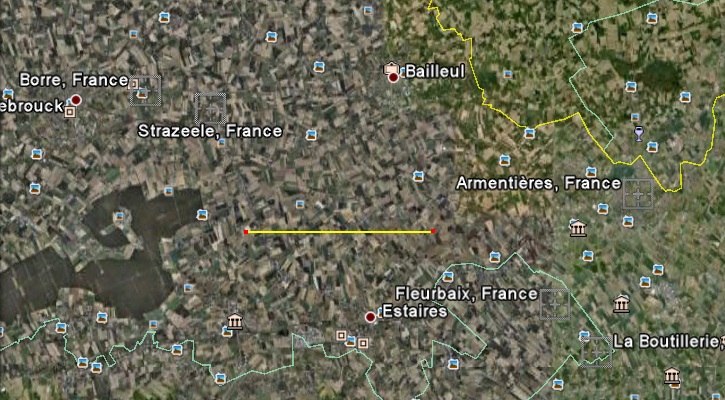
The diary for March is fairly
constant in the recording of working parties, time in
billets, being shelled both on the line and in billets and
a continual flow of casualties with one or two people
being killed or wounded each day. On March 10 the
battalion “stood to” all day because of the battle of
Neuve Chapelle. ("Standing to" meant that everyone was on
the line with rifles loaded prepared to deal with an
attack. Generally those in the line would stand to in the
first and last hours of the day when visibility was
limited yet good enough for an attacking force to see
while having some protection from being observed.
George in the Ypres Salient
On the first of April the
10th Battalion was moved to a rear area at Estaires, a
rest position. Until the 4th inclusive their daily routine
consisted of Musketry and physical training, trench
digging and practice in attack, and drill and route
marching. At 7:00 am on the 5th the battalion
left Estaires passed through and at 3:00 pm arrived at
Abele (note: misspelled Abelle in the diary) about 3 miles
south west of Poperinghe, on the edge of the Ypres
Salient. There is no entry in the diary for the 6th and
from the 7th through the 10th the battalion engaged in
company drill, route marching and practicing battalion
attacks. They were inspected during this time by Lt. Gen.
Alderson and then on the 11th were inspected by
Field Marshal Sir H. Smith-Dorien. They continued their
training program through the 13th.
Then on 14 April the
battalion was loaded in 40 buses and was transported
to Valmertinghe from where they marched to Wieltje
(about two miles north east of Ypres on the Ypres-St.
Juliaan road) in the Ypres Salient. Guides supplied by
the French then led them into positions in the
trenches and the battalion took over about 1500 yards
of trench from French troops. By 4:30 am all rations
and ammunition had been delivered to the trenches.
The battalion stayed in the trenches near Wieltje
until the evening of the 19th. During this period they
expended much energy improving the sanitary and
defensive condition of the trenches which were
considered to be filthy with refuse and decaying
bodies and to be almost indefensible for lack of depth
and barbed wire protection. During these four
days the battalion lost 2 men killed and 11 wounded.
On 20 April the battalion
was in the divisional reserve near Ypres. This reserve
was close enough to the lines to be shelled
occasionally. It stayed there through the 21st and for
most of the 22nd in a rest position. This process of
spending a few days in the trenches and then rotating
out to a rest position was the normal sequence of
events for line battalions. While in the trenches
there was little time for rest, meals were generally
(this early in the war) cold and it was a time of
considerable discomfort with little facility for
personal hygiene and rest. After a few days of this
troops would be exhausted and need a respite and so
would be rotated out of the line. Coming and going was
always a bit dangerous because troops were more in the
open and most of the access routes were well known and
vulnerable to enemy shelling. Such shelling occurred
if the enemy suspected rotation but also occurred on a
random basis in the hope of disrupting rotation and
re-supply activity.
In the late afternoon of
the 22nd, a bombardment was heard to the northeast. A
gas of a greenish gray colour was observed and a
strange odor noticed. This was the first use by the
Germans, on the western front, of gas to support an
attack. The gas used was chlorine.
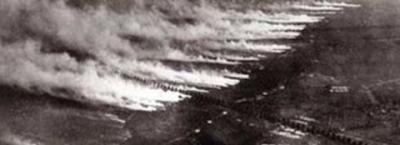 |
| Gas attack. This may
be a photo of the attack on the French lines on 22
April 1915 |
By 6:00 pm the battalion
was marching towards the trenches they had previously
occupied at Wieltje. Their return was impeded by "the
masses of French troops proceeding toward YPRES in great
disorder, there were also masses crossing the fields in a
South Westerly direction, many having thrown away anything
that could impede their progress." [from the war diary].
The French troops had broken under the impact of the gas
attack, leaving a large gap of about 8,000 yards in the
lines. The 10th battalion was amongst the troops being
rushed forward to plug the gap. With some consultation
among staff a counter attack was planned and the battalion
was arranged with "A" Company on the right, "C" Company on
the left forming the front two lines, and having been 30
yards distance. "B" Company on the right and "D" Company
on the left forming the 3rd and 4th lines. They were
supported by the 16th Canadian Infantry Battalion.
At 11:48 p.m. the attack
commenced and " not a sound was audible down the long
wavering lines but the soft pad of feet and the knock of
bayonet scabbards against thighs. In C.company a hedge was
unexpectedly encountered and the noise of breaking through
brought on a hail of bullets, rifle and machine gun fire."
[from the war diary] The trench was cleared by 11:55 and
the battalion pushed on into a wood. There followed
several hours of confused fighting with elements of the
10th and 16th battalions becoming intermixed and digging
in to try to hold positions gained.
By 6:30 on the morning of the
23rd "When the two battalions (10th & 16th) assembled
their men it was found that we had 5 Officers being: MAJOR
D.M. ORMOND, CAPT. C.J. ARTHUR, LIEUTS. W.N. KNOWLES, S.L.
GLANFIELD and W.R. CRITCHLEY the only one had been wounded
being CAPT. C.J. ARTHUR, who had a slight scratch on the
right cheek, this did not prevent him carrying on. There
were 188 Other Ranks that were left out of 816 of all
ranks" that had attacked with the 10th.
For the first time, in these
entries, we start to see specific details of deployments
and mention of the 4 separate companies in the battalion.
Unfortunately, at the time of writing, we do not know what
company George was in so we are not able to determine
where exactly he was in the disposition of troops.
The battle continued for
several more days, engaged heavily with the enemy. About
26 April a casualty list was forwarded which included the
name of George Henry Scott. To date I have not been able
to locate this list.
A transcription of the war
diary with links to the original diary pages is available on line. On the
transcribed entry for 30 April there is a list of those
killed by day which includes "21523 SCOTT, GEORGE HENRY"
However there is no link to the original from which this
list came.
The form reproduced above
indicated that a month later, on 21 May, George was
officially listed as missing and struck off strength. The
following year on June 16 his status was changed to
presumed dead with date of death 22 April 1915.
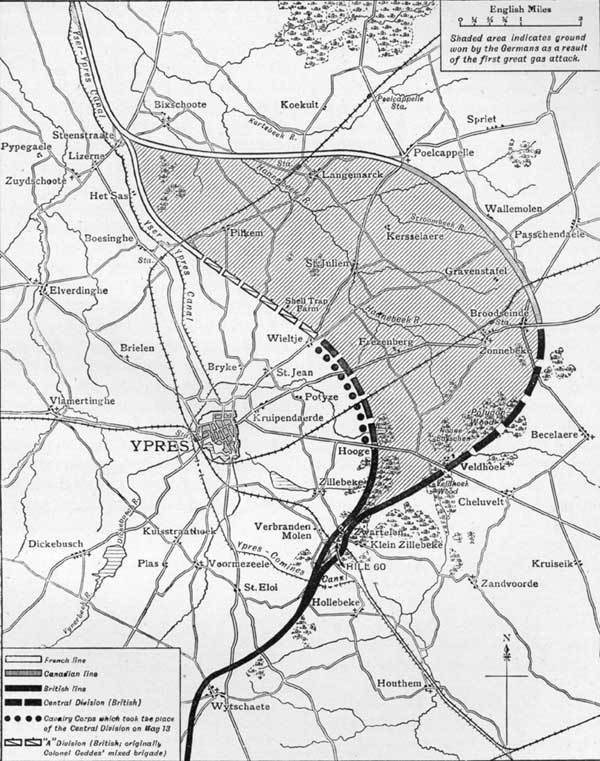 |
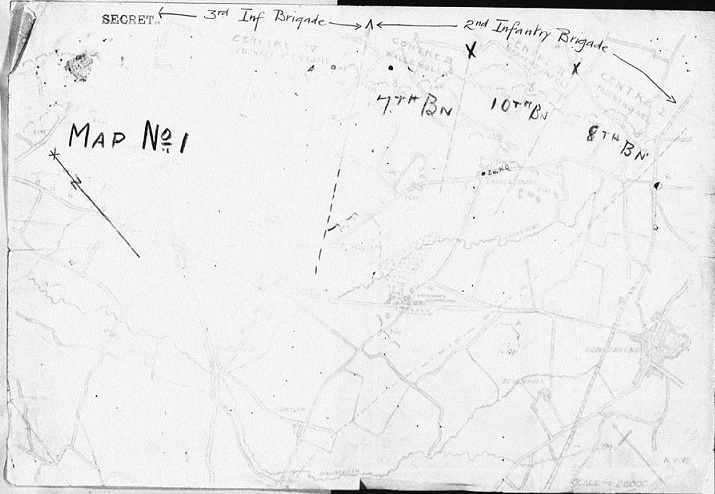 |
| A map showing the
battlefield at Ypres during the second battle of
Ypres and showing the ground won by the Germans. The
Canadian lines are shown before the battle. The 10th
Battalion would have been roughly in the area of the
name Gravenstafel on the map |
The dispositions of
the Canadian brigades in a sketch map prepared by
Lt. W. A. Lowery. He was injured in the battle, but
survived the war. |
In Flanders Fields
In the last days of the month the battalion was placed on the Yser canal near bridges three and four. On this canal and near one of these bridges was a Canadian Field hospital where a few days later on about May 3th the doctor Lt-Col John McCrae of the Canadian Expeditionary Force composed the well-known poem In Flanders Fields.
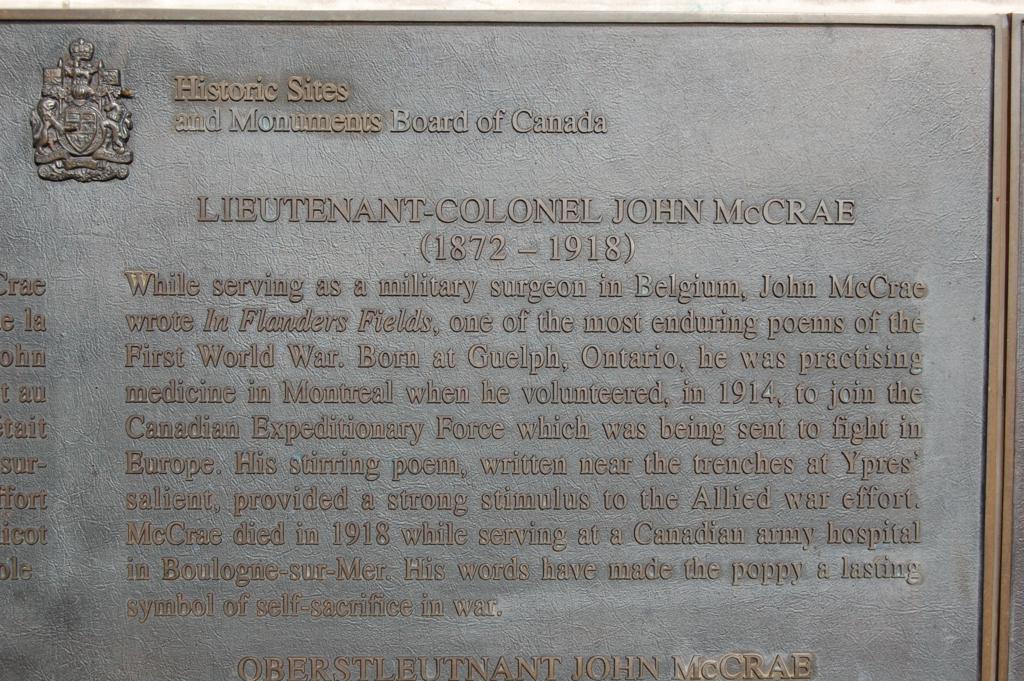 |
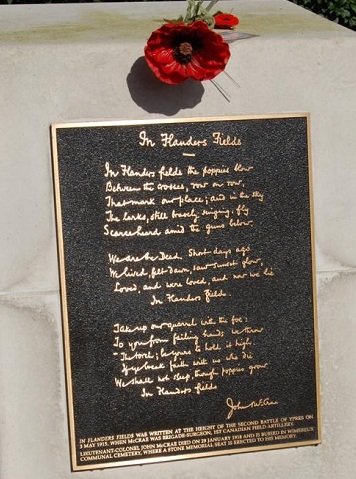 |
| Memorial
Plaque honouring Lt. Col. John McCrae |
The
poem as it appeared in his handwriting |
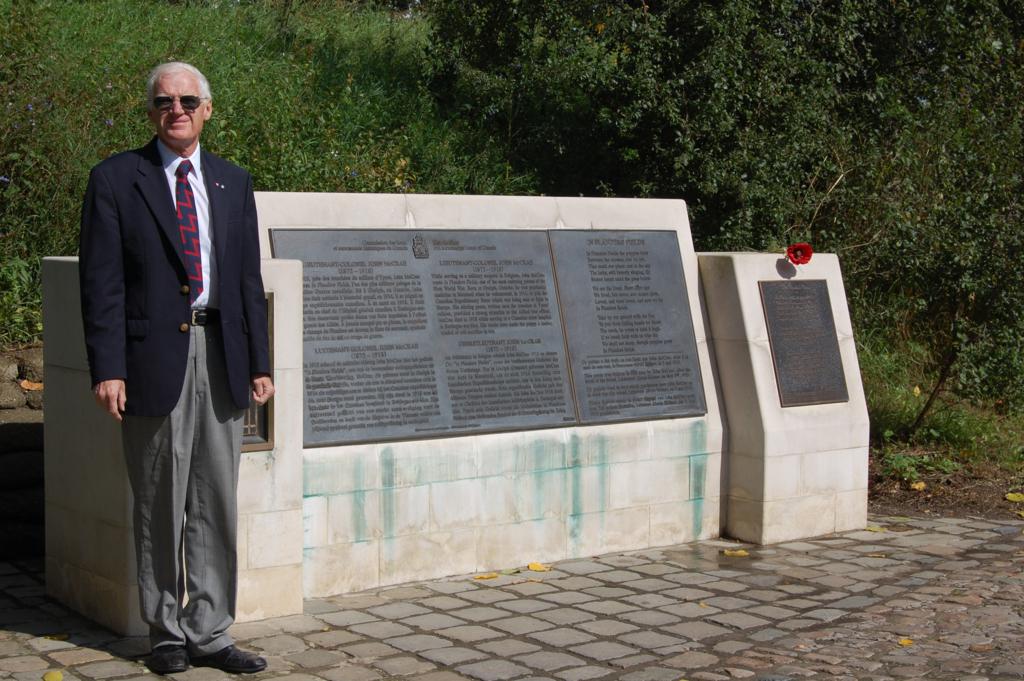 |
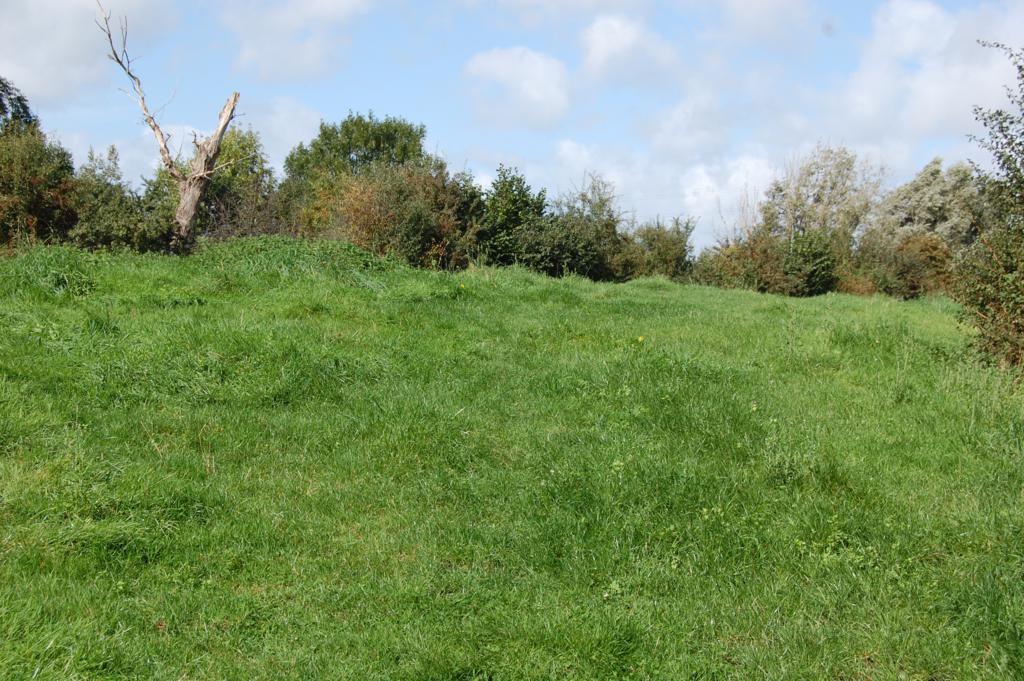 |
| The author standing
beside the McCrae memorial During the Boer War
McCrae was an artillery officer in what is now
called the 30th Field Regiment RCA(M). I was also an
officer in that regiment and wear the regimental
tie. |
The field on the bank
of the Yser Canal where McCrae purportedly composed
his poem. |
After the Death of George Henry Scott
The form reproduced above indicated that a month later, on
21 May, George was officially listed as missing and
struck off strength. The following year on June 16 his
status was changed to presumed dead with date of death 22
April 1915.It is not known if his body was ever recovered. We do know that it was never identified. It might have been buried in one of the graves of unknown soldiers. It is also possible that his body was blown to pieces during one of the artillery barrages of the battle. After the battle the battleground ended up in the hands of the Germans and his body might have just been unceremoniously buried in a mass grave (often large shell holes were filled with bodies and covered over). As a consequence there is no marked grave for him.
Childhood and His Life in Canada
About 8 years of George's life was spent in the Royal Navy and the Canadian Army. But for about 18 years he was a child growing up and then a pioneer on the Canadian prairies. In the notes below we provide some information related to these years.George Henry Scott was born 6 September 1888 in Shepherd's Bush, London, England. Shepherd's Bush (also "Shepherds Bush") is an area of west London in the London Borough of Hammersmith and Fulham, situated 4.9 miles (7.9 km) west of Charing Cross, the center of London. He was the son of John Thomas Scott and his wife Sarah Thomas. He was christened at St. Saviour's, Shepherds Bush on 23 November 1888 [Ancestry.com record recovered by Jean Reed].
His father in 1891 and 1901 declared that his trade was that of a house painter, although Jean (Scott) Reed reports that he was also a warder at Wormwood Scrubs at least for a few years (continuing a family tradition of working as prison warders; both his father and grandfather had been prison warders). In 1891 the family was living in Hammersmith but by 1901 were located in Fareham next to Portsmouth and close to George's paternal grandparents.
George appears with the family in the 1891 census of the United Kingdom as a boy of 2 and in the 1901 census as a boy of 12; these images can be seen on his parent's biographical pages.
His childhood and education ended at no later than the age of 15 when on 25 May 1904 he was on strength aboard HMS Erebus, a depot ship probably at Portsmouth. It is interesting that he became a domestic servant and one can only wonder if he had previously worked in this capacity. His paternal grandfather was a publican (managed a pub) in his retirement and George might well have served in the pub from an early age. His military career in the navy is discussed above.
When George "ran" from the navy, he evidently went to Canada. There is a feeling in the family that George went to Canada partly because other family members had preceded him to Canada. We do know that my grandfather, Frank Scott, went to Canada in 1909 with the Melbourne family. Frank was a second cousin of George but, although I knew my grandfather fairly well and discussed genealogical items with him from as early as 1952, I cannot recall ever hearing mention of a cousin George going to Canada. My father also had no recollection of any such links.
During his time with the navy George apparently did a number of paintings some of which survive in the family. Two, of luzzus, are shown above. Some others are shown below and these were probably done while he was in the navy
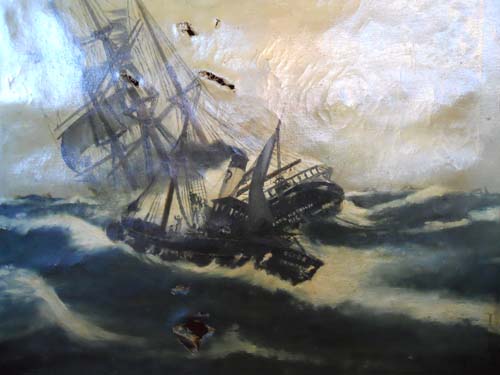 |
The painting of two ships on the left is interesting. It is of a small steam/sail conversion craft, the Clyde, Crimea?? which is leeward of the Anna Mathilda P.IC(?). The Clyde has someone standing in the foredeck with his hands in the air. There are three figures climbing into the rigging of the Anna Mathilda. Does this represent a famous race? |
This is an interesting painting of a two or three masted ship (likely a barque) running under full sail. Is there a story behind this painting? |
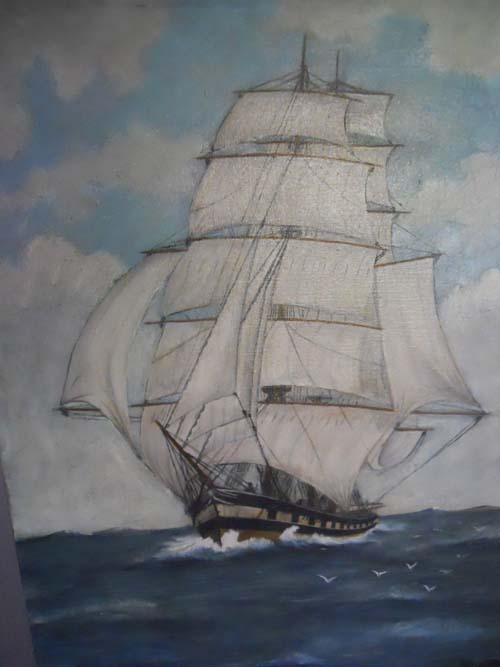 |
When George went to Canada he quickly became a homesteader on the Canadian prairies.
Homesteading:
George was in the province of Saskatchewan by January of 1912. On 23 January 1912 he filed an application for an entry for a homestead on the following properties:and
N.E. 1/4 Section 23 Township 31 Range 28 West of the 3rd Meridian
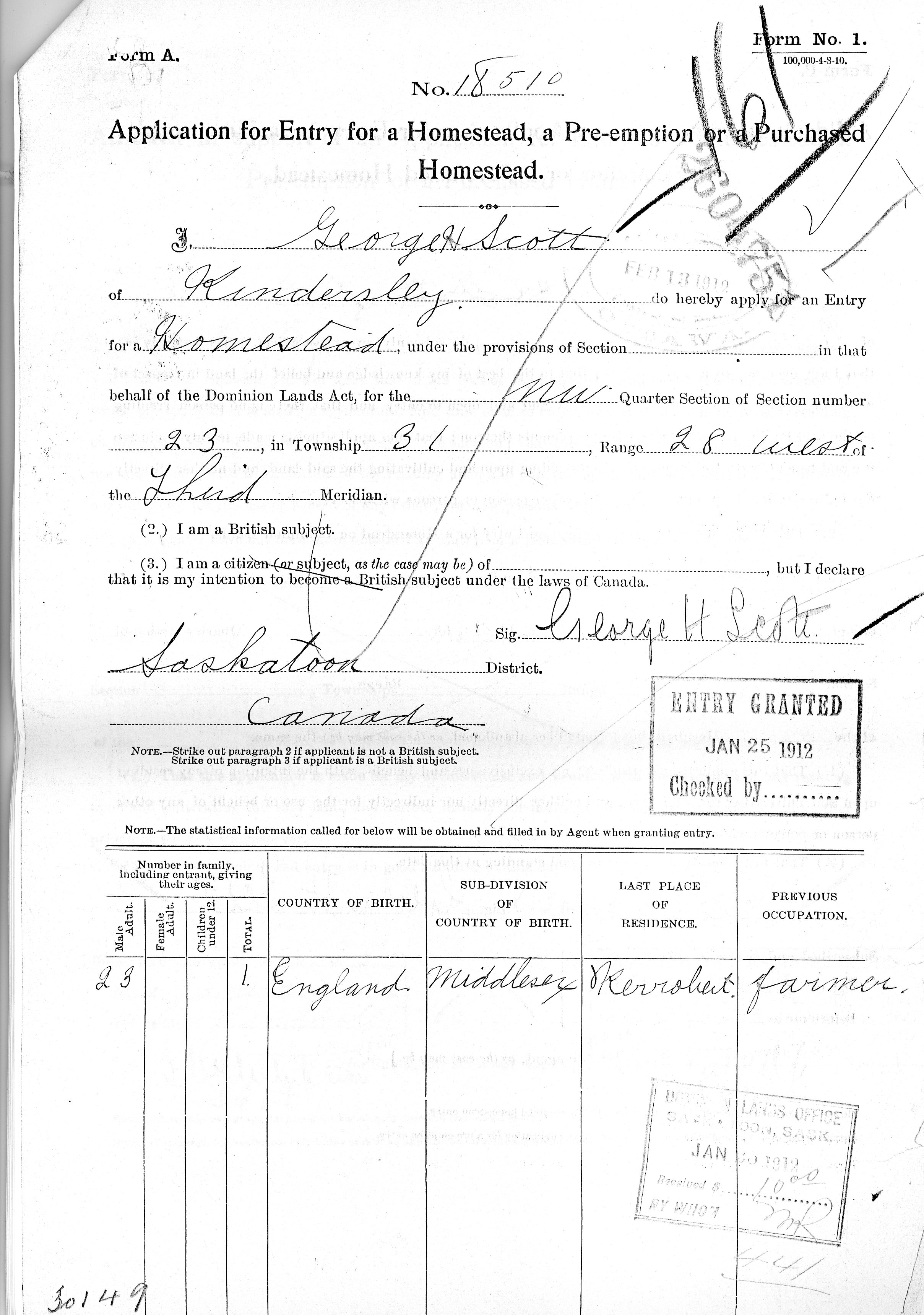
This document is interesting in that it provides some information on George's whereabouts as well as providing an example of his signature. It reveals that his last place of residence was Kerrobert (in Saskatchewan) and that he had been a farmer there. At the same time it reveals that he is currently 'of Kindersley' (in Saskatchewan). It also indicates his age, that he is not married and that he was born in Middlesex, England (Shepherds Bush was in Middlesex at the time of his birth). The document also indicates by stamp that the homestead was granted on 25 January 1912, two days after the application.
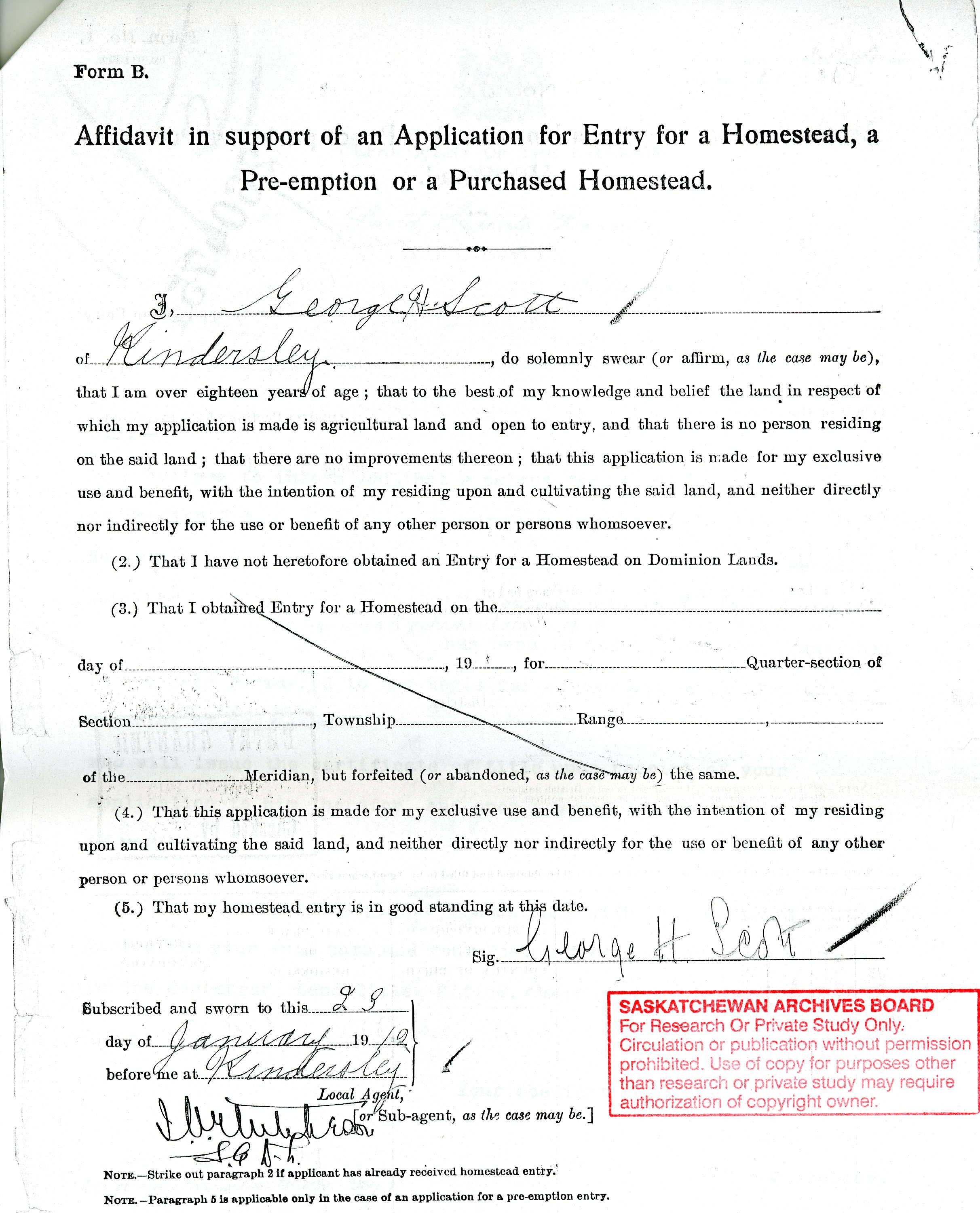
This document adds little but does give another example of his signature (evidently the forms were prepared by someone else and then signed also by the Land Act agent in Kindersley.
The applications were granted on 25 January 1912 by the local land agent. This information was obtained from the Saskatchewan Archives Board. It is to be noted that there are several homesteads that were awarded to one or more persons with the name "George Henry Scott". We can be certain that these applications were from our George by the fact that ownership of these quarters passed to his father John Thomas Scott in 1917 (as further detailed below).
| Note on homesteads: During the period 1872 - 1918 the Dominion of Canada had in place a Dominion Lands Act for the granting of land on the prairies, to homesteaders, at no cost other than a $10 administration fee. A homesteader could apply for two adjacent quarters (a quarter was a quarter square mile, equal to 160 acres or 65 hectares). The homesteader was required to cultivate 40 acres and place a permanent dwelling on the property within 3 years. George's application was made under this act. |
The following satellite view shows the location of Loverna where George homesteaded in relation to other places in Western Canada.
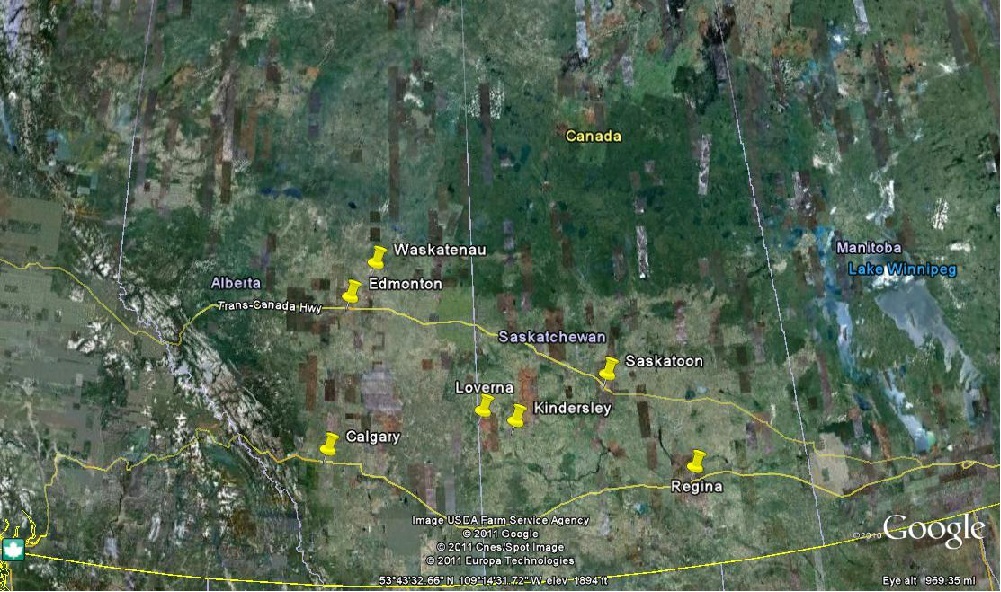 |
| This map shows part
of the Canadian prairies including the southern
areas of Alberta and Saskatchewan. Loverna, where
George homesteaded is almost on the Alberta-
Saskatchewan border and half-way between the two
major east-west highways in Canada. Kindersley
where George registered his homestead and where he
lived at least part of his time in Canada is close
by. Also shown is Saskatoon where he enlisted.
Waskatenau, 60 miles northeast of Edmonton is
where his second cousin Frank Scott homesteaded in
1909, but it is not know that there was ever any
communication between them in Canada. The straight
line distance from Loverna to Waskatenau is about
200 miles (325 kilometers). |
Part of the Dominion Lands Act was the surveying of the prairies which created the one mile grid system which persists to this day. The grid system of quarter-section-township-range-meridian can be converted to longitude and latitude and the first of the the two quarters granted to George is located at:
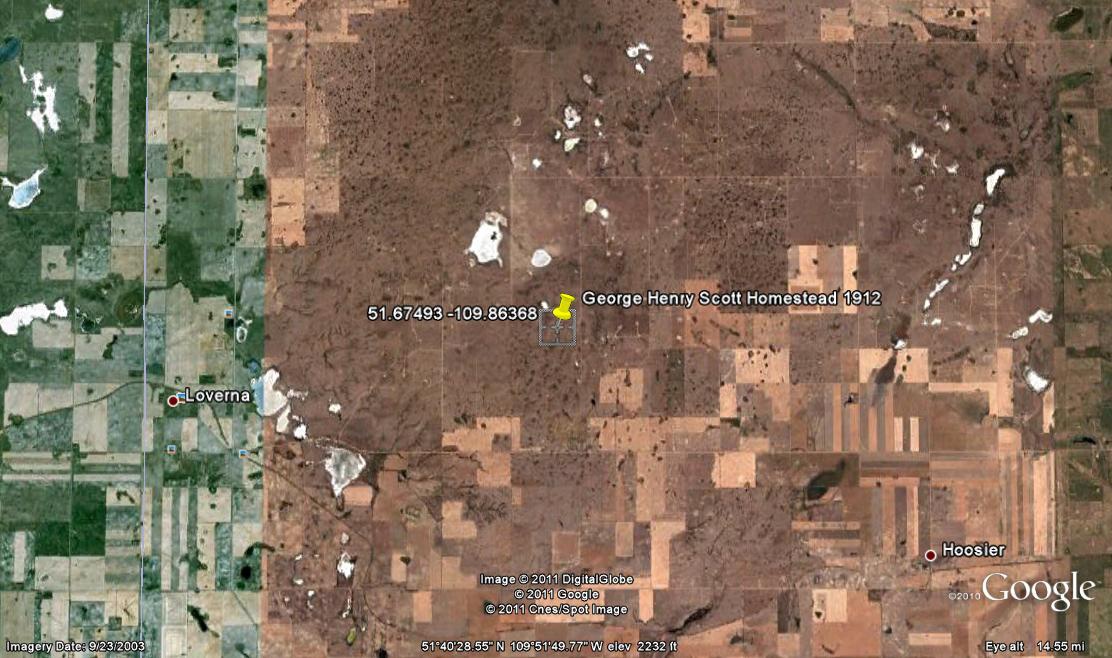
The property is located on very arid land just outside the town of Loverna. The land does not appear to have any buildings on it at this time and may be unused. Today Loverna is essentially a ghost town with a population of only about 5 persons.
While we can be certain, as further documented below, that this homestead did belong to our George Henry Scott, it is possible that other homesteads were taken out by him -- this will warrant further investigation.
Since it is clear that George was in Canada by January of 1912 it is natural to ask if he was in Canada early enough to be included in the 1911 census of Canada which started on June 1. So far I have not been able to locate him in the census but it is possible that he is somewhere in Canada at that time. Kerrobert is in the Battleford census district and Kindersley is in the Moose Jaw census district in 1911. Both these locations have more than one G. or George or George H. Scott. however none of them match our George for year and month of birth. A further search of the Canadian census for 1911 does not locate a George Scott born in September 1888 who could be our George Henry. It would therefore appear that he arrived in Canada in the last half of 1911.
From January 1912 until he joined the army at the outbreak of WWI, we have no further information on him. It is probably clear that he did not take up residence at his new farm on 25 January. There were no buildings there and, unless he was into arctic camping, it would not be possible to live at that location at that time of year (when temperatures can be expected as low as minus 40 degrees). In his affidavit he indicates that he is of Kindersley at the date of application and it is likely he was working there at that time, most likely as a waiter in a hotel (which was the occupation indicated in an obituary in the Kindersley paper after his death.
Background note:
This biography of George Henry Scott has been constructed from comments made by his niece Jean (Scott) Reed in a series of emails, partly in response to my queries for more details. Jean stated:
| "My cousin Marjery
told me that she remembers her mother (Agnes)
getting a telegram and throwing herself on the bed
in floods of tears because she said her brother
had been killed in the war (the first World War).
" (31 July 2010) "My Uncle Joe (real name George) was apparently killed in World War 1. I know nothing else. I do not even know if he was in the army or air force. He was born in 1879. . . .Some of the family thought he went off to Canada (or maybe America) with his father John Jr. It seems more likely that it was Canada because of the family link to that country." (1 August 2010) "Uncle Joe was spoken about by Aunt Sally. I know that he painted pictures of sailing boats and I am pretty sure that he was in the navy. I assumed that would be the Royal Navy but that is because my father and Uncle Arch were both in the Royal Navy as opposed to the Merchant Navy." (2 August 2010) "I forgot to say, Uncle Joe was born George in Hammersmith (Shepherd's Bush) London in 1889. " (2 Aug 2010) "I am afraid I do not know much about Uncle Joe. He was mentioned, of course, but I always got the impression that he was in the navy. I am not even sure that he went to Canada/America. It is all hearsay from different members of the family. It is just that my cousin, Marjery, had said that he had been killed in the First World War. " |
Fortunately this seems to have been enough information to start the process of recovering his life and, in the process, to recognize the sacrifice he made. As my investigation proceeded I came to realize that "Joe" was just a mispronunciation of "Geo" which was the name that he went by and which appears on the Loverna memorial shown above.
PostScript (1) -- The 100th anniversary of the Battle of
Saint Julian, 22 April 2015
The traditions of the 10th Bn. are perpetuated in Canada
by the Calgary Highlanders, an infantry militia regiment
of that city. The battle of Saint Julian, the first major
engagement of the 10th Bn. which resulted in 75%
casualties is remembered by the Highlanders each year by
memorial services and dinners, usually at the regimental
headquarters in Calgary. In 2015 a contingent of the
regiment raised their own funds to travel first to London,
where they were reviewed by Her Majesty, Queen Elizabeth
II, and then to Ypres.
I was privileged to be able to participate in the
commemorative events of the Highlanders in Ypres.
On the afternoon of the 22nd they held a memorial service
a the Brooding Canadian at Sint Juliaan. At dusk the
regiment participated at the Menon Gate for the daily
memorial Last Post ceremony that has been held at the gate
every evening since 1929, with the exception of the years
of the German occupation during WWII.
In the evening a commemorative dinner was held at the
farm now located where the battle of Sint Juliaan took
place. The current owners of the farm and the local
community converted one of the large sheds into a dining
hall. A lovely meal and lots of drinks were served. The
fields of the Ypres area are still producing every year a
'crop of iron' which the farmers put at the edge of their
fields for pickup and disposal. Each visitor, that
night, was given a momento collected from the battlefield
by the local school children. I was given a shell casing.
At the time of the battle the wood which was the
objective of the counter attack by the 10th Bn. was known
as St. Julian Wood, after the nearby town. The wood,
before the battle had been the location of the kitchens of
the French troops who were dispersed by the gas attack. It
became known to the troops as the "Kitchen wood". When the
British took over that section of the line the name was
morphed to "Kitchener's Wood" by which name it became
known from that time onward. The colonel of the Calgary
Highlanders, in his comments to the assembled at the
evening dinner, said that it was a point of honour to the
10th Bn. that the battle be known as the battle of St.
Julian wood. In spite of his comments local memorials
refer to the wood as Kitchener's Wood as seen in the
photos below. (click on any photo to see an enlarged
version)
PostScript (2) -- A Visit to Loverna
In June of 2018, I visited Loverna while on a trip from Calgary to Moose Jaw for a convention. It was not that easy to locate the town having to rely on some crude maps as I did not have a GPS. It required driving down some very narrow, mostly one lane roads and using a sense of direction.The town is now a ghost town, whereas in 1912 when Geo homesteaded there, it was an important maintenance hub for the Canadian Pacific Railway. There were 5 families living in the town when I visited. One of the families was Ray and Sheila (unfortunately, I have lost their surname) who were kind enough to show me around the town and let me see the town hall which had some historical artifacts from earlier days. In addition to the four families and the community center I was able to take some photos of the memorial as well as to see the exterior of the Anglican Church which is seldom used now.
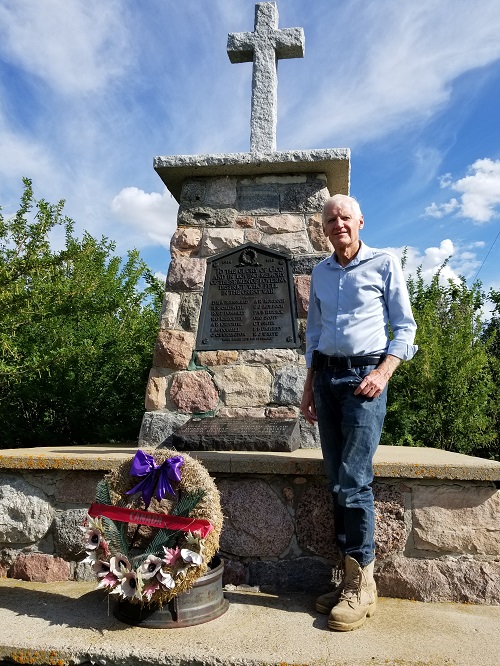 |
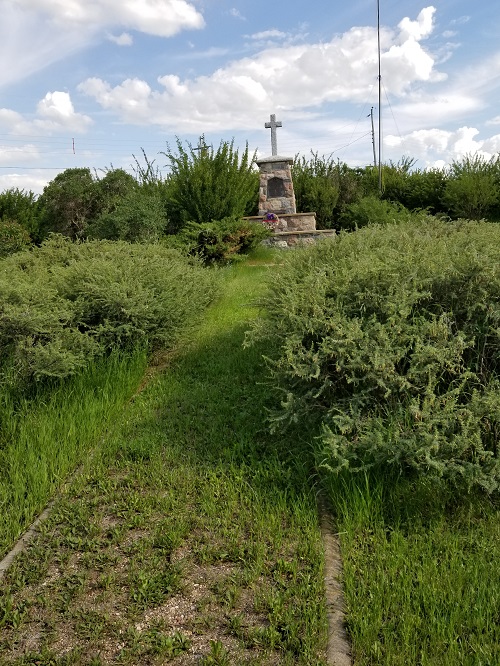 |
| The author standing at the Loverna
Memorial. The wreath had been there some time but it
was nice to see it -- someone remembers! |
With almost no one living there, the
memorial grounds are not maintained regularly but I
was assured there is an annual clean up. |
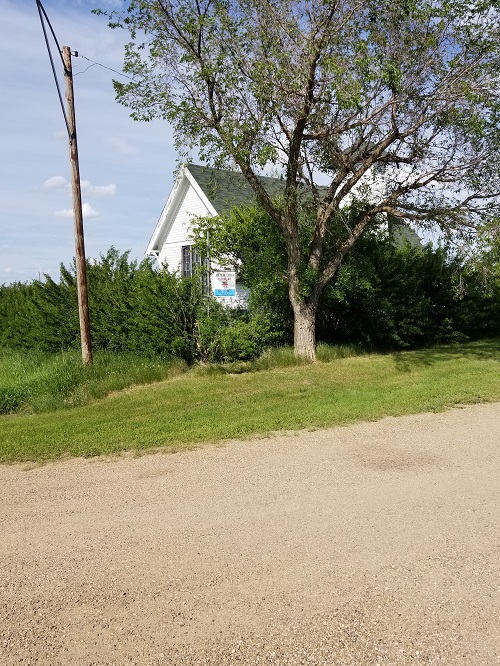 |
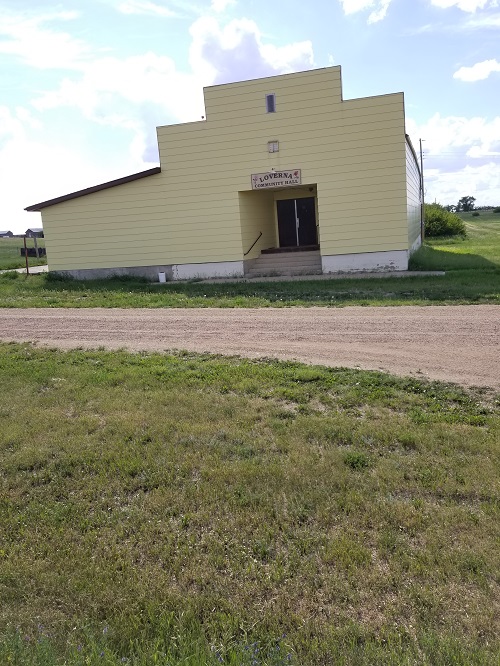 |
| All Saints Anglican Church in
Loverna. The building is maintained but seldom used |
The Loverna Community Center. The
building was funded by a former town resident who
won a lottery. It contains some memorabilia and is
used from time to time for reunions of former
residents. |
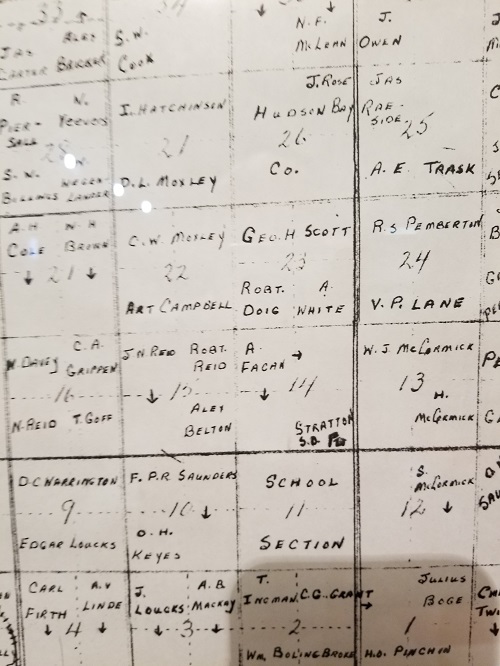 |
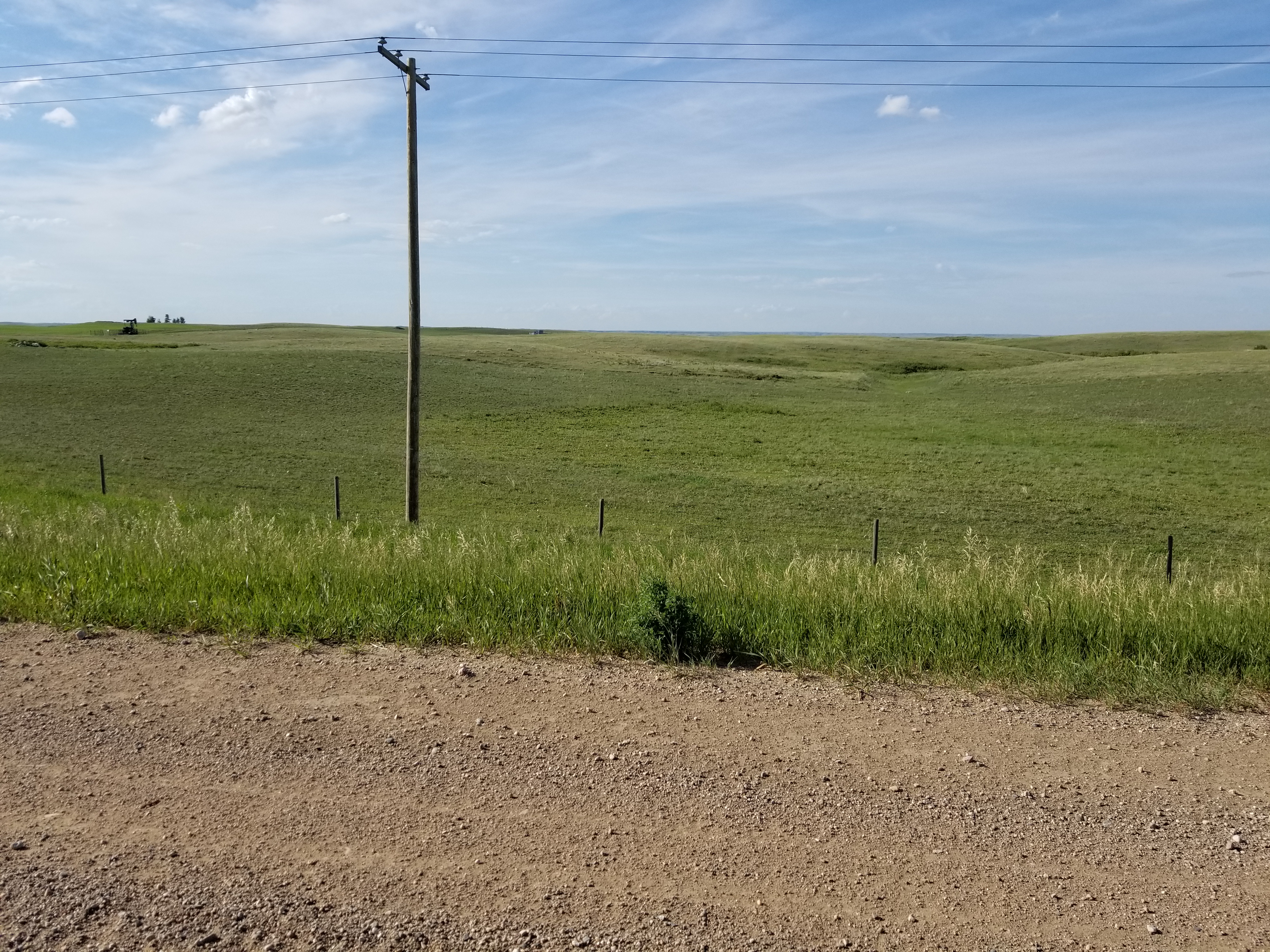 |
| This is an image of part of the
homestead allocation map that is in the community
center. In approximately the middle of the image in
square 23, the top half is allocated to Geo, H,
Scott. The map is dated 1912. Each square is one
mile on each side. A quarter of a square is called a
'quarter section' and is 160 acres in size.
Generally a settler filed on one quarter and had the
option of taking an adjacent quarter subject to
certain development commitments. Geo would not have
had time to meet those commitments at the time this
map was drawn. Much of the western prairies were
surveyed and allocated in this manner. It is
interesting to see one section (11) allocated to the
school and also, north of Geo, a section (26)
allocated to the Hudson's Bay Co. |
A photograph, taken from the car, of
land about a mile south of Geo's quarters. While
looking verdant it is, in fact, little more than
pasture land -- not suitable for crops -- and now
all part of a large community pasture. Due to sparse
rainfall and long, cold winters this land can only
support about one head of cattle per 3 acres.
Although having 320 acres, as Geo had filed for,
sounded fabulous by British standards, it was not an
easy way to make a living. |
PostScript (3) -- A Visit from Scott Taylor, the Medals, and more family history
On 20 February I was contacted by Scott Taylor, a grandson of John Thomas Scott who had seen my biography of his uncle George Henry ("Buster") Scott 1921 - 1944, a half brother to Geo. We have communicated since that time. Scott has supplied many photos of the family, although none of John Thomas, nor of Geo, and some information on the family. In January 2020, Scott visited and brought various medals and other memorabilia for me to see.One of the boxes contained medals from the first world war, the medals that were awarded posthumously to Geo and which I had despaired of ever locating. The box was labeled "Mom's Uncle". "Mom" was Scott's mother Margaret Anne who had been raised to believe that her half-brother Geo was her uncle -- confirmation of some earlier speculation.
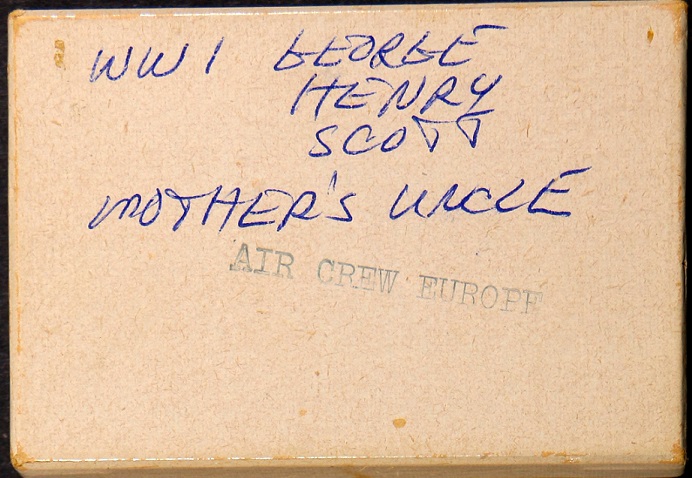 |
This image is of the cover of the box
in which Geo's medals were stored for many years.
The box, itself, was one that came with the medals
of Geo's half brother Buster who was killed during
WWII. The writing on the box bears witness to the understanding in the immediate family that Geo was an uncle of Margaret Anne Scott, Geo's sister, and indicates that they did not realize that their father was also the father of Geo. |
The Canadian government awarded George the campaign medals given to soldiers of his time. They included the 1914/15 star, the Victory medal and the British War Medal. These awards are recorded on the card shown below:
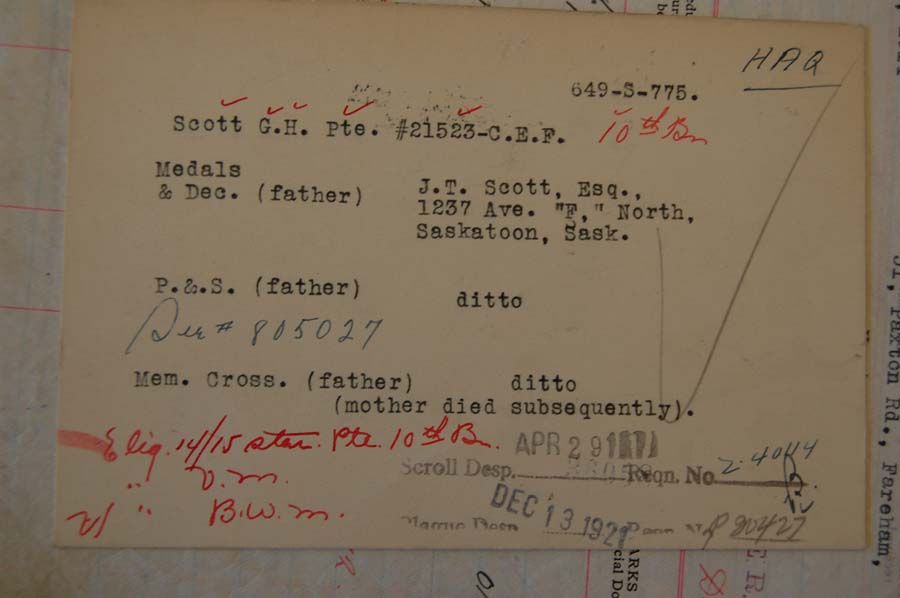
The Canadian government also presented a plaque and scroll (P.&.S.) in 1921 which were sent to his father. A memorial cross was also awarded to the widow or mother of a deceased soldier. This, too, was sent to the father and the card is annotated that the "mother died subsequently". This was not the case and the full story can be seen in the biography of the father John Thomas Scott b. 1857.
The Medals awarded 21523 Private George Henry ScottThe top row of images shows the obverse of the
medals which is what is seen when they are worn.
When mounted for wearing they are in the order
(left to right ) shown below. The reverse of the
medals is not usually seen. |
||
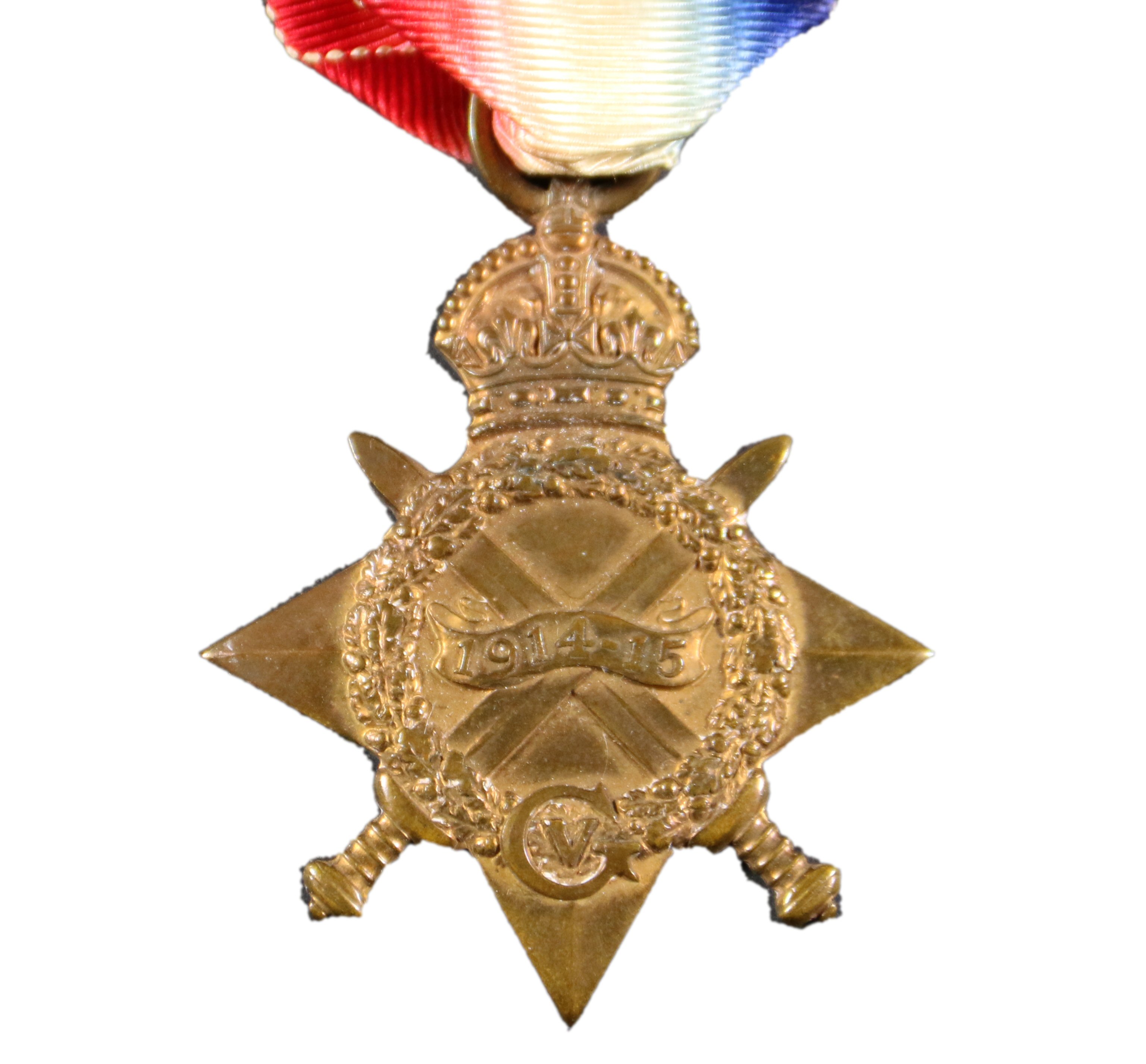 |
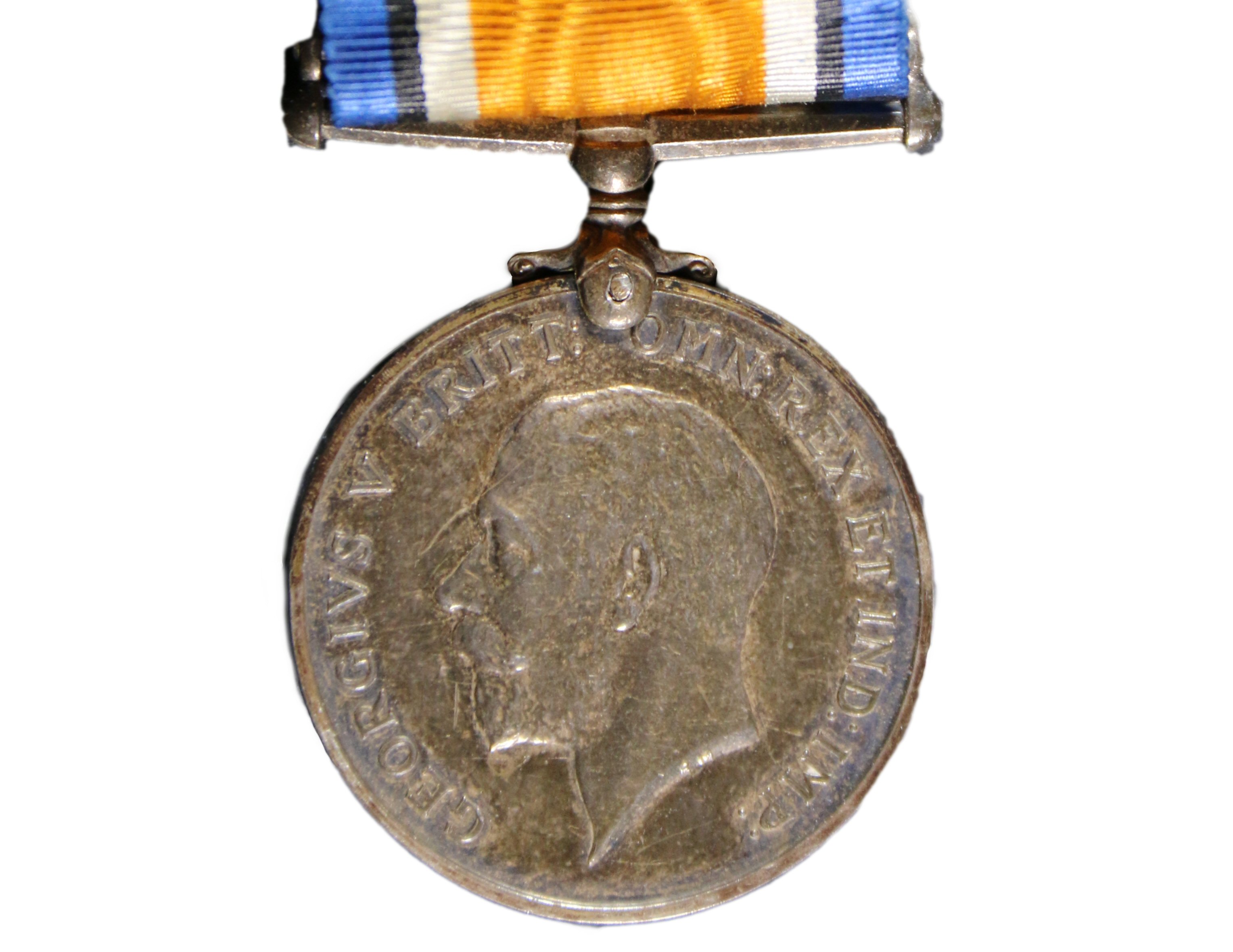 |
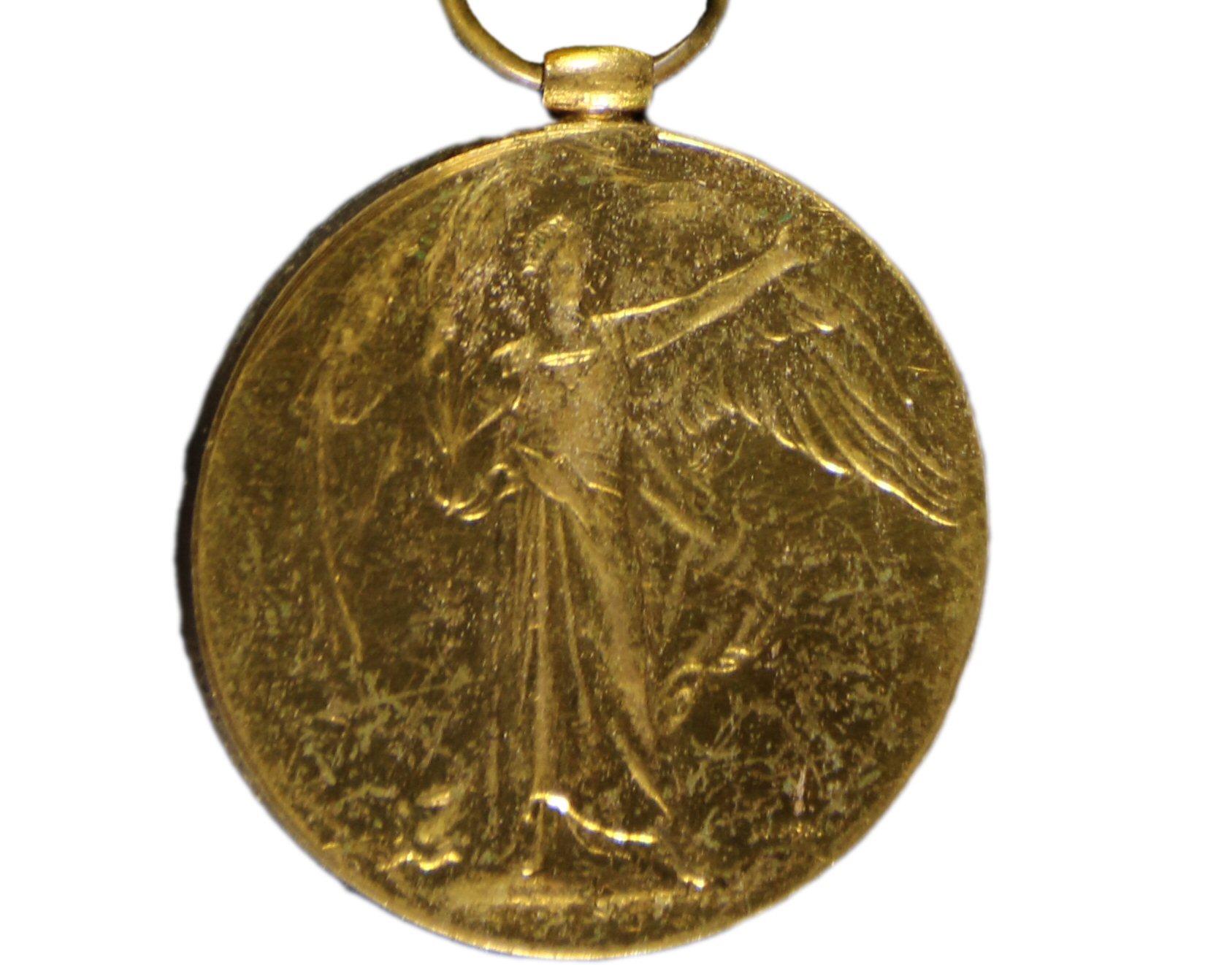 |
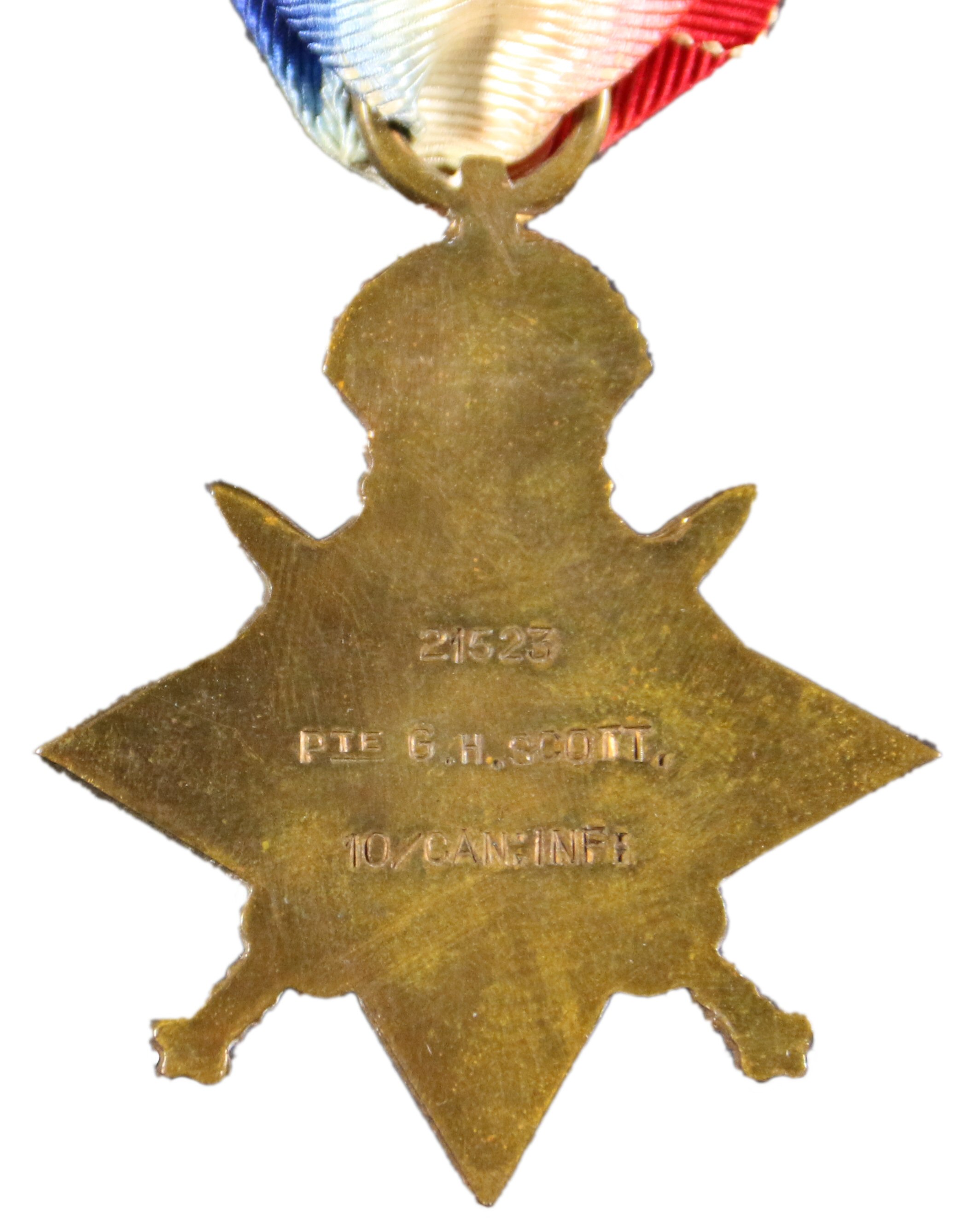 |
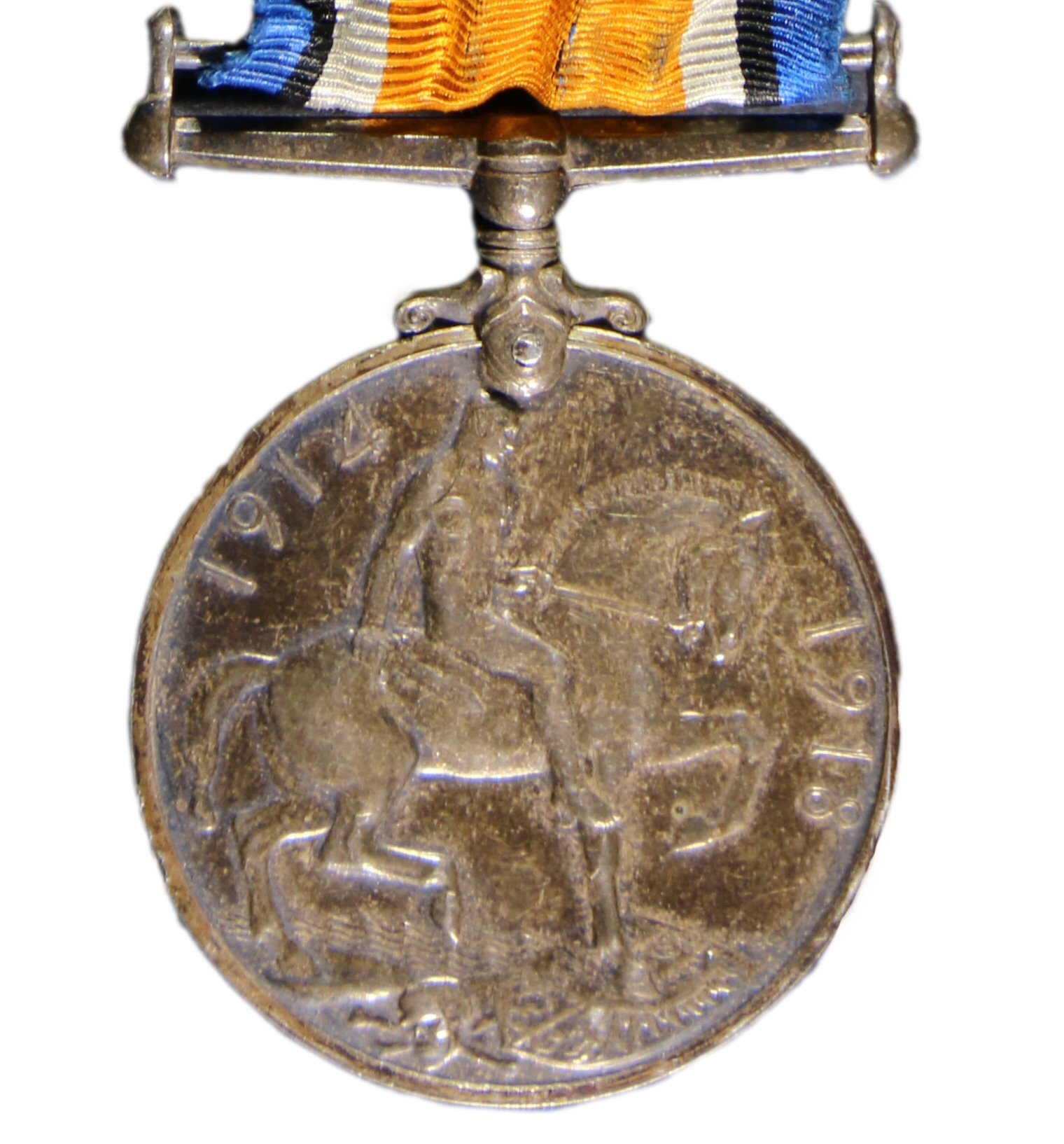 |
 |
|
The 1914-15 Star
Awarded to those who saw service in any theater of
war between 5 August 1914 and 31 December 1915. The
reverse of the medal is stamped with Geo's
identifying details:21523
Pte. G.H. Scott 10/CAN.INF. |
The British War Medal Awarded to all who served in WWI. It is silver and inscribed on the rim are his personal details |
The Victory Medal Awarded to all received the 1914- 15 star. it is a bronze disk. Inscribed on the rim are his personal details |
There were also memorial items awarded to his parents to commemorate his sacrifice and the loss to his family. These would normally have been sent to his mother Sarah Scott, but, as noted above, it appears that his father notified the government that Sarah had died (she died many years later in 1959 at the age of 93). The memorial cross and plaque and scroll were instead sent to his father, John Thomas Scott.
 |
 |
| The Memorial Cross (often called
the silver cross) was issued by the Government of
Canada to the next of kin (usually mothers or wives)
of soldiers who were killed in the war. As indicated
above, Geo's father had advised the government that
Geo's mother was dead. The cross could be worn by
the recipient. |
The Memorial Plaque issued by the
British Government to the next of kin (usually
mothers or wives) of soldiers who were killed in the
war. They were about 4.75 inches in diameter
and cast in bronze. The plaque was accompanied by a
scroll with the name of the casualty. This scroll
for Geo has probably disappeared. |
In 1919 the community of Loverna came together and presented memorial watches to the next of kin of those from Loverna who had been killed in the war.
 This is a photograph from the awards ceremony in Loverna on Veteran's Sports Day, July 1, 1919. A gold watch similar to that received for Geo, is being presented to Bert Brimstead whose brother, David Horace Alexander Brimstead was killed 8 August 1918. It is quite possible that John Thomas Scott, Geo's father, traveled to Loverna for the ceremony, The gold watch in memory of Geo is in the possession of Scott Taylor, Geo's half nephew. The other panels show images of the watch. It is interesting to see the large crowd attending the event, given that today it would be difficult to find 10 people in the town at one time. |
 |
 |
 |
PostScript (4) --Photographs from a Niece
Recently I received two photographs from Jean Reed, Geo's niece who started me on the quest to find out what happened to Geo. These are shown below| Of the photo on the left
Jean says: " the two young men are, I believe, my
uncles Arch and Geo". She states that the image on
the right is of her uncle Arch in 1927. Geo was born
in 1888 and Arch in 1890. Arch was later a
sharpshooter in the Royal Navy and the photo on the
right was taken at Bisley. In addition to the photo on the left which might include Geo., there are three other photos in which he might appear:
It would be helpful to use face recognition
software to see if we can conclude that Geo is one
of the two men in the photo above left. |
|
Future Research
While we have managed to obtain much information on Geo we would still like to:
- locate some photographs of him
- learn more about his life in Canada before he returned to England
- obtain a copy of the obituary in the Kindersley paper
- use face recognition technology to try find a photo
for Geo.
Acknowledgements
- The Commonwealth War Graves Commission site for details of his resting place and date of death.
- The Archives Canada site for copies of his attestation papers.
- Veterans Affairs Canada for access to the Memorial
Book Page Image
- Jean (Scott) Reed, niece of George Henry, and her husband Patrick Reed, who provided information which made this research possible
- Ypres second battle map from the website: http://wwii.ca/content-19/world-war-i/second-battle-of-ypres/
- Tanya Wheway for a note on the luzzus in Malta
- National Archives in the U.K. for the record of service in the Royal Navy
- Charlotte Edwards of Delta, B.C.. formerly of the Loverna area, who contacted me and supplied images of the memorial there.
- Andy Sims who supplied a copy of the close up of the dedication plaque.
- Leo Colsell who provided the photographs of the harbour in Malta as well as comments on the paintings by George.
- Scott Taylor who possesses the medals and memorial items and who provided photographs of them for inclusion above.
- Sheila and Ray in Loverna who showed me around the
town and gave me access to the community center.
©Kenneth Scott, Jean Reed and others 2010,2011, 2020
email: ken at kenscott.comlast revised 5 April 2020





